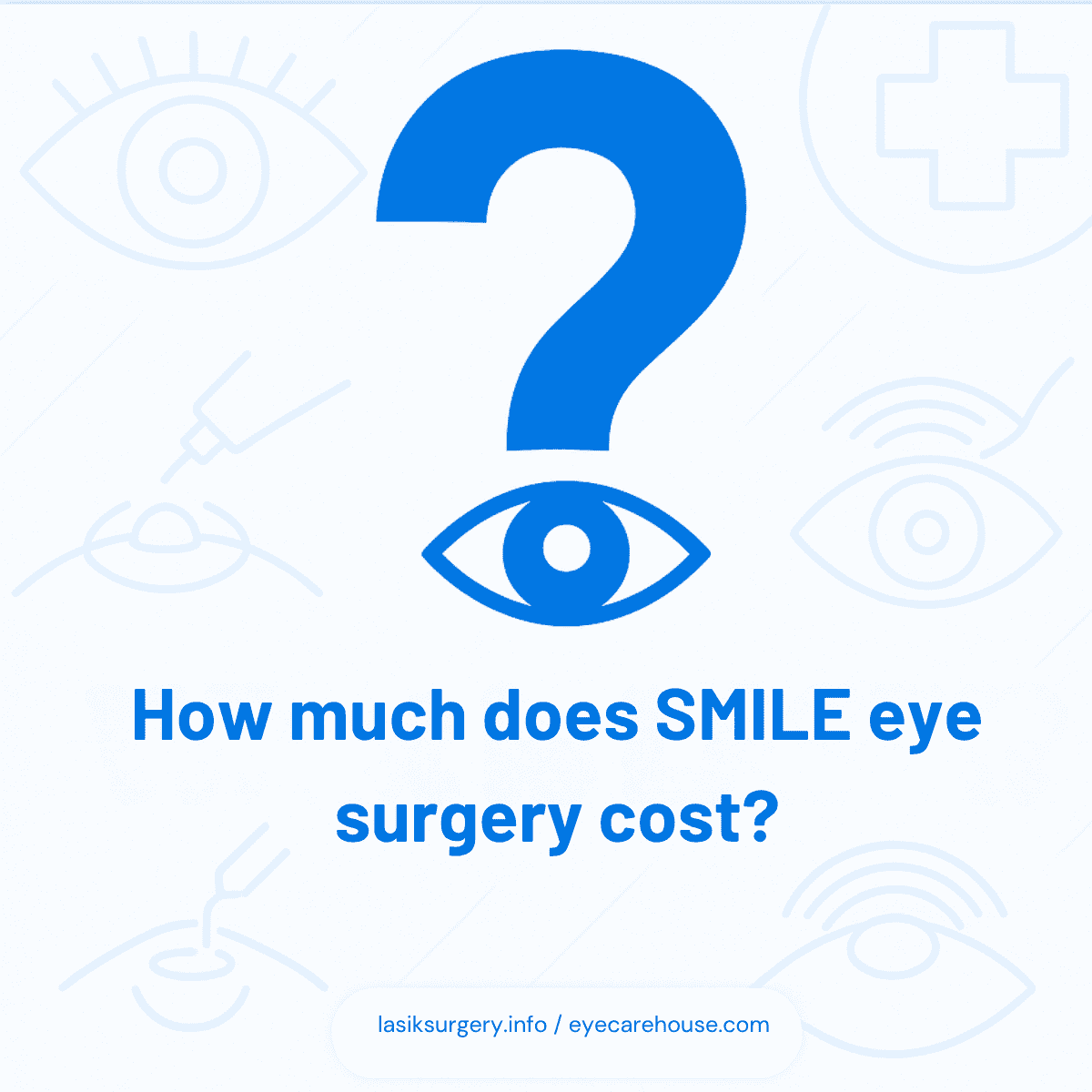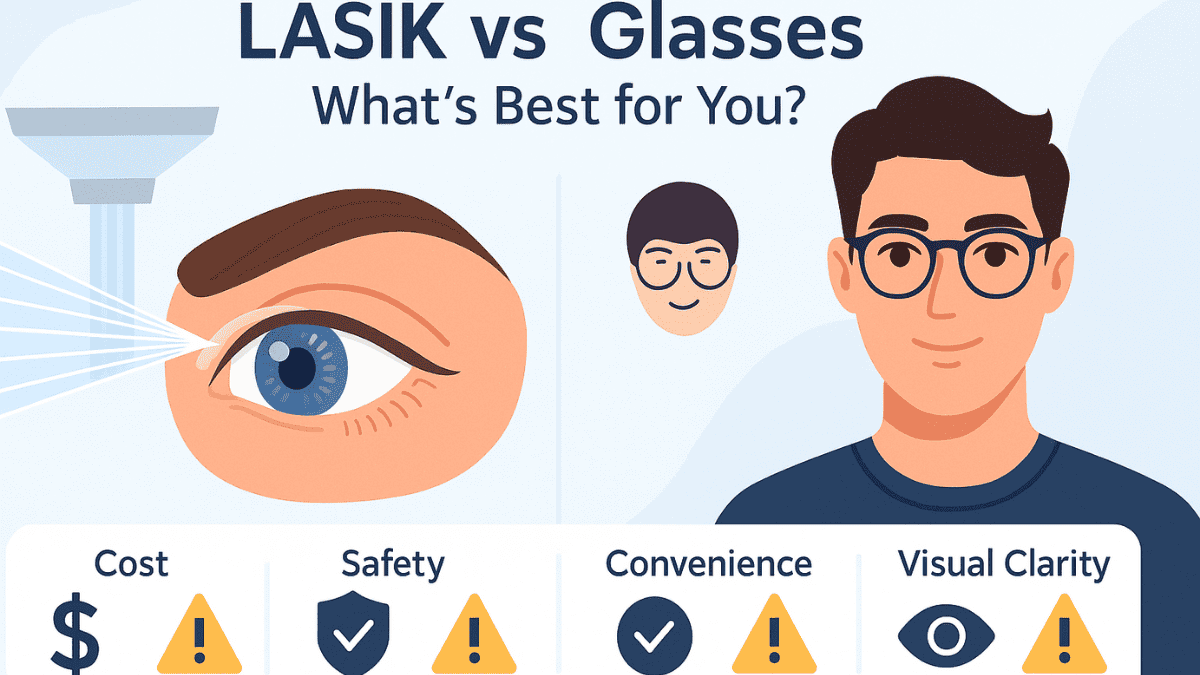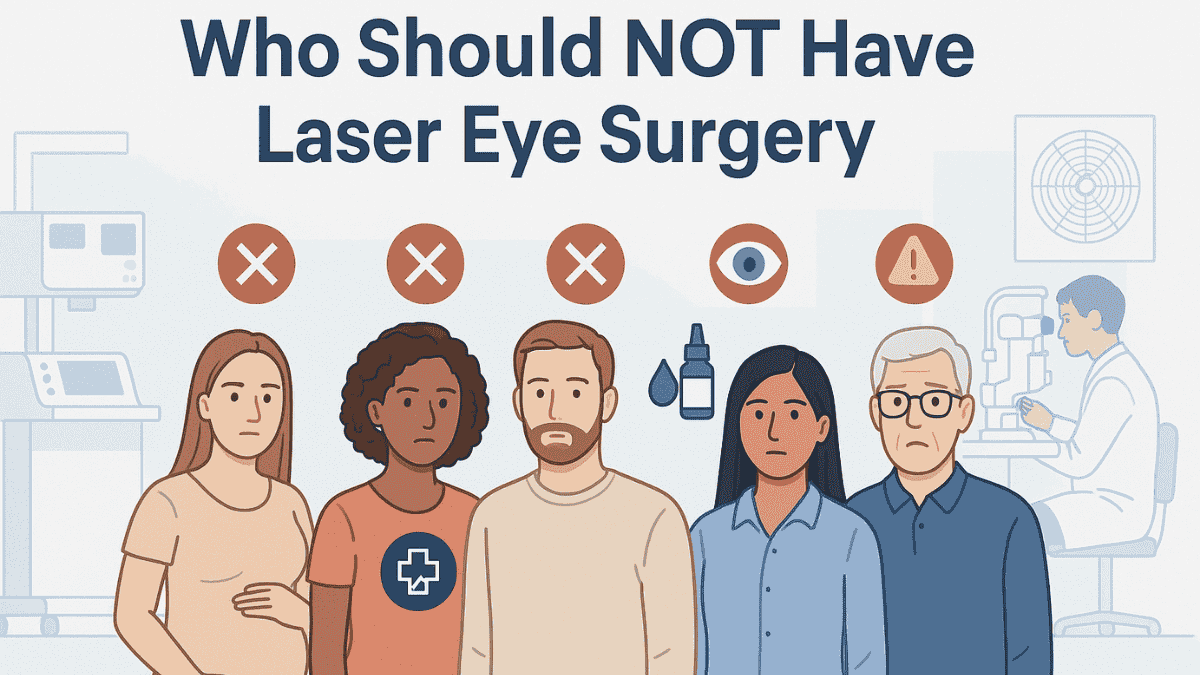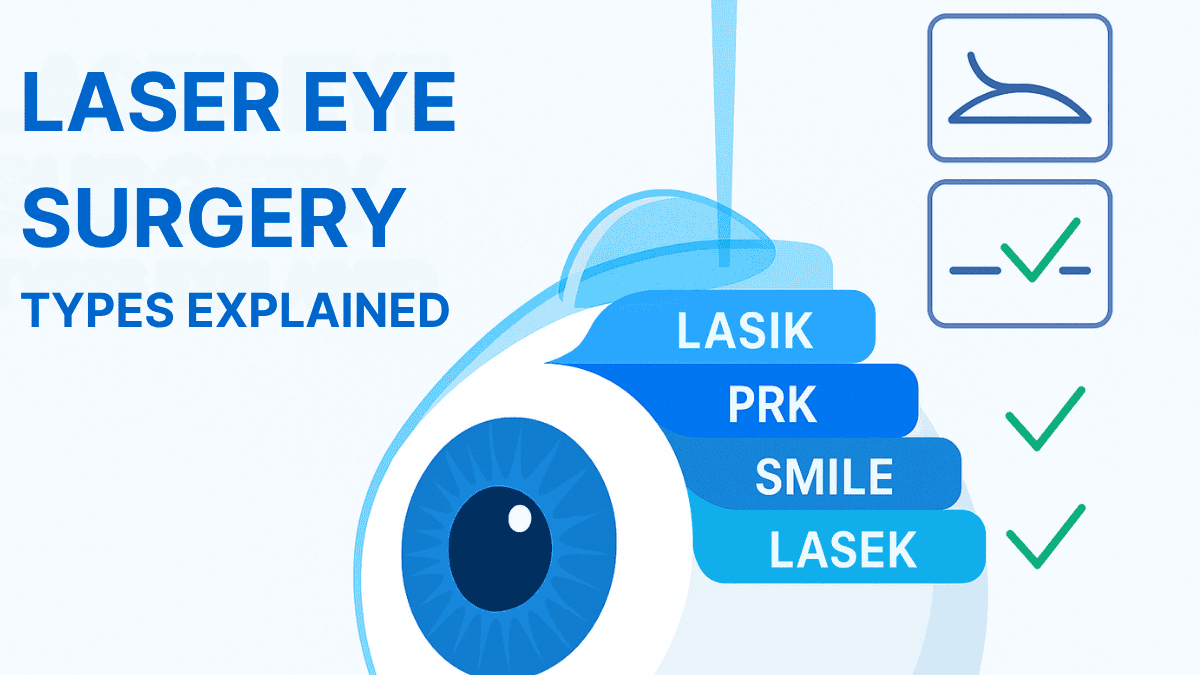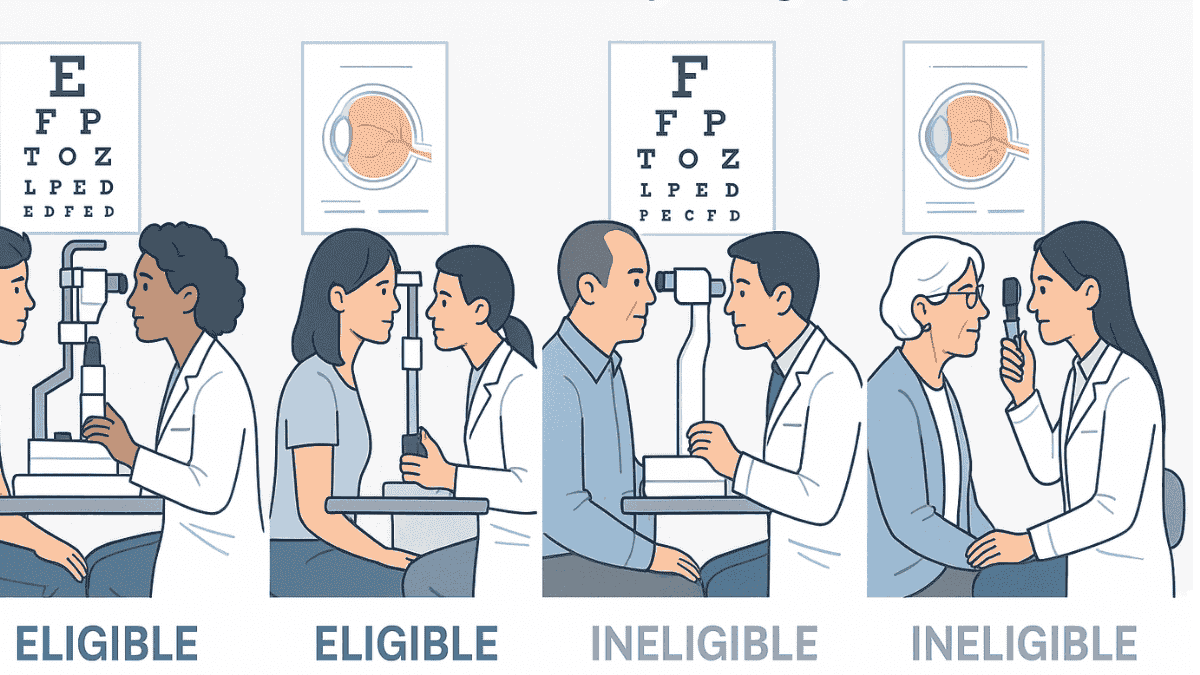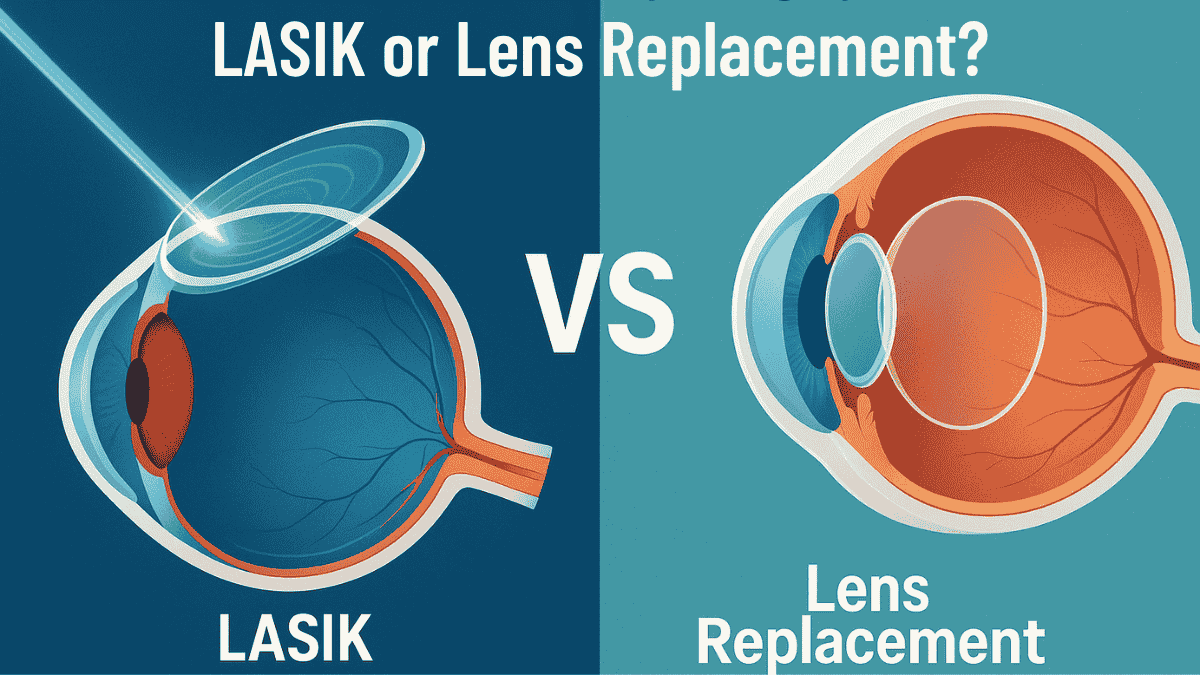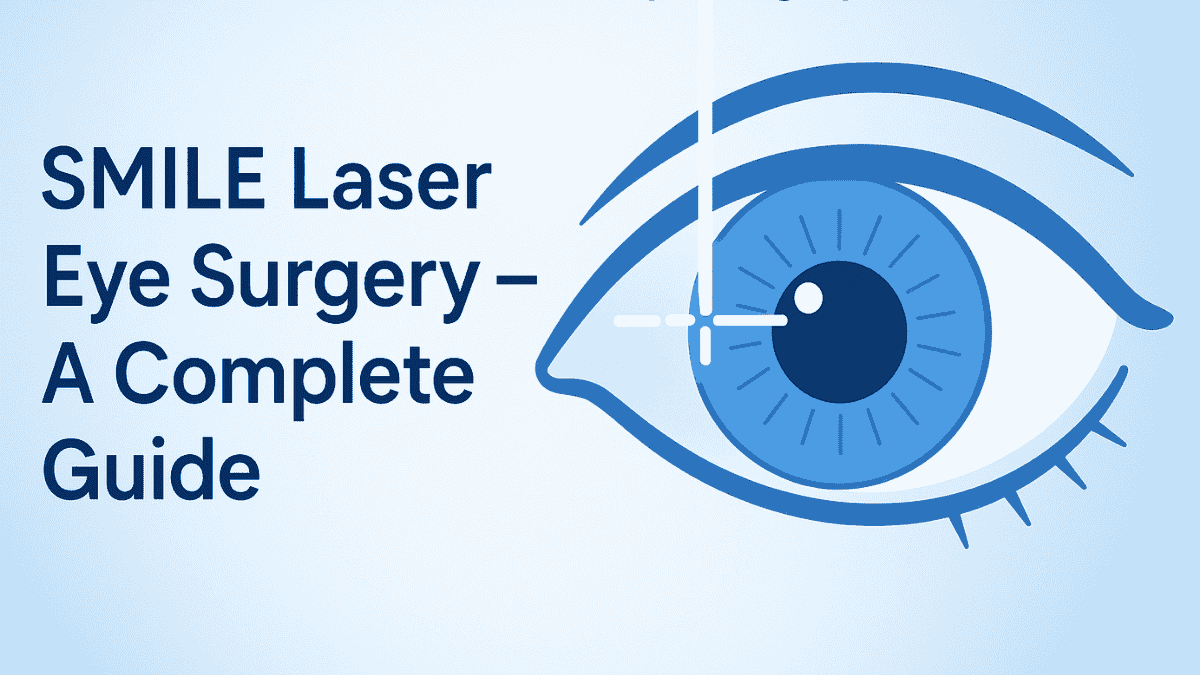
Dreaming of life free from glasses or contact lenses? If so, you’ve probably looked into vision correction and might be curious about smile laser eye surgery. This advanced laser treatment, a type of laser eye surgery, is reshaping how people achieve clearer sight. Understanding if smile laser eye surgery is the right path for you is important.
With various options like LASIK, PRK, and the SMILE procedure, the amount of information can seem extensive. It is natural to have questions about how these treatment methods differ. This guide aims to bring clarity to your options for corrective eye surgery.
Table of Contents
What is SMILE Laser Eye Surgery All About?
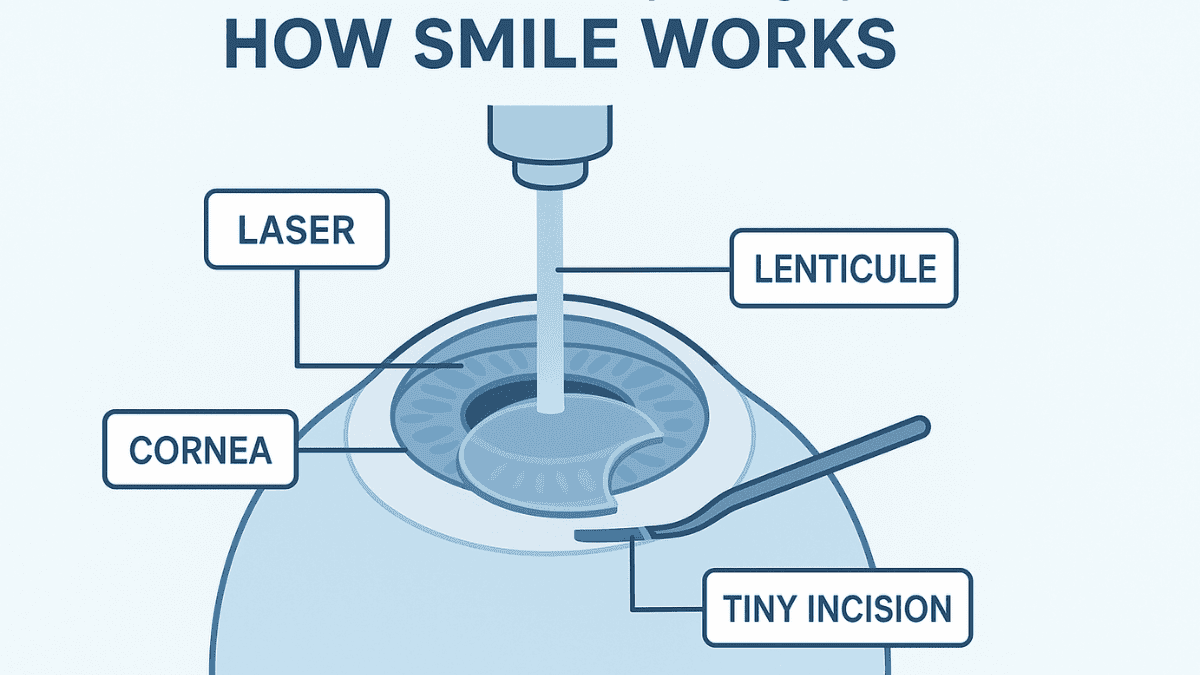
What is the innovative SMILE procedure, sometimes known as ReLEx SMILE? SMILE is an acronym for Small Incision Lenticule Extraction, a specific type of smile eye surgery. This technique is a more recent development in laser vision correction, offering a distinct approach.
The primary purpose of SMILE surgery is to address common vision problems. It mainly corrects nearsightedness (myopia) and can effectively treat astigmatism. During the smile laser treatment, the surgeon employs a highly precise femtosecond laser. This laser carefully carves a small, lens-shaped piece of tissue, known as a lenticule, from within the cornea.
The surgeon then performs the lenticule extraction through a very small incision. This careful removal of the lenticule reshapes the cornea. Properly shaped, the cornea can focus light correctly onto the retina, leading to improved vision. The SMILE laser eye surgery itself is a sophisticated process.
A key difference from other laser eye surgery methods is that SMILE avoids creating a large corneal flap. This is a significant aspect of its design, emphasizing a gentle, minimally invasive surgery. This approach sets smile laser eye apart from some traditional techniques.
The Technology Behind SMILE
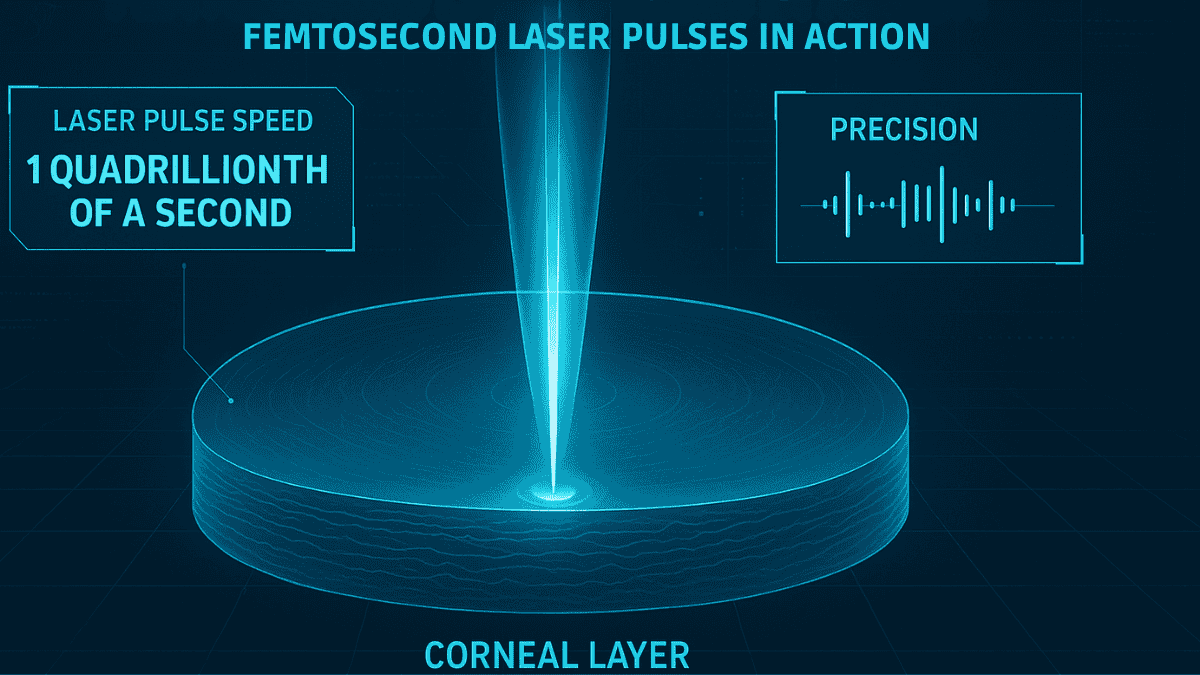
The advanced laser technology is central to the SMILE eye surgery. The procedure uses a specific type of laser known as a femtosecond laser. This laser is not ordinary; its defining features are exceptional speed and pinpoint accuracy.
A femtosecond laser emits pulses of light that last for an incredibly brief duration—one quadrillionth of a second. This rapid pulsing allows the laser to create extremely precise separations within corneal tissue. Importantly, it achieves this without producing significant heat, which minimizes impact on the surrounding eye structures. This level of precision is fundamental to the successful outcome of your smile laser eye surgery.The femtosecond laser is used to laser create the lenticule with remarkable exactness. It also forms the very small incision required for the lenticule extraction. The laser portion of the smile procedure typically takes minutes, often surprising patients with its swiftness.
How Does the SMILE Procedure Actually Work?
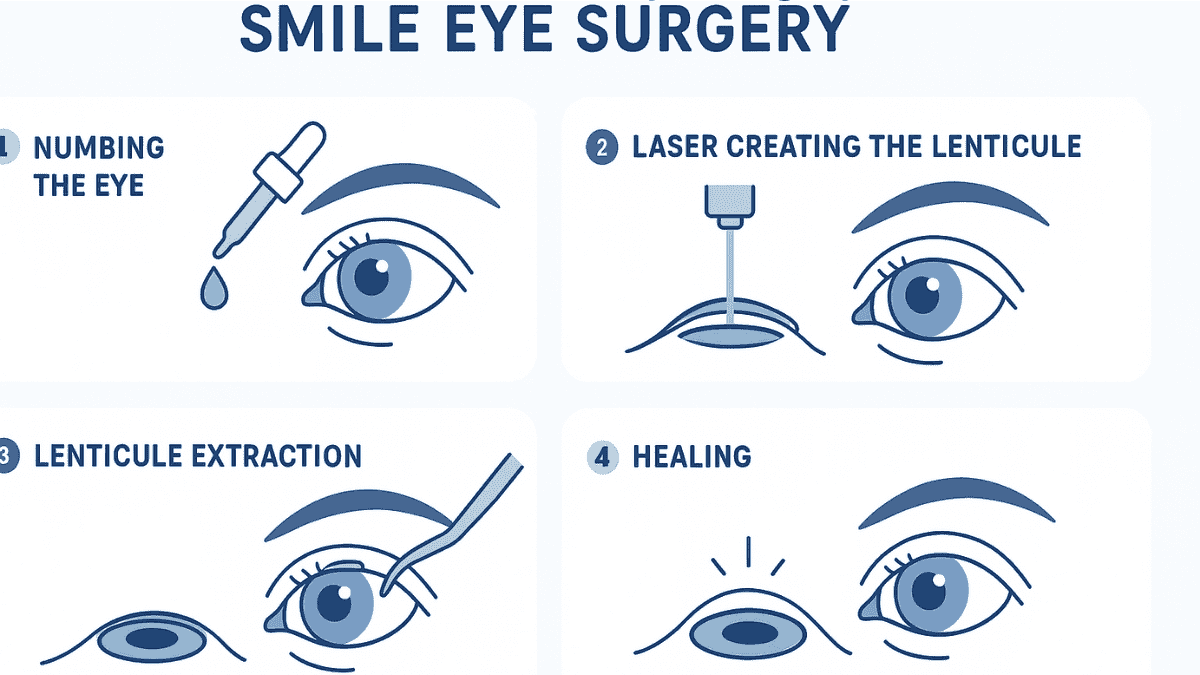
The SMILE procedure, despite its sophistication, is a relatively direct process with distinct steps. Understanding these steps can help clarify what happens during the laser treatment. Let’s review the general flow of this corrective surgery.
Initially, your eye is numbed using anesthetic eye drops. This means you should not experience pain during the eye surgery, although you will remain awake. Some individuals report feeling a slight pressure sensation, but discomfort is minimal.
Following the numbing, the femtosecond laser is activated. You will be instructed to focus on a target light while the laser works. The laser then precisely creates the lenticule within your cornea and forms the small incision, typically just 2 to 4 millimeters in width, for its removal.
After the laser completes its task, the surgeon carefully uses specialized instruments. They gently separate the lenticule and extract it through the previously created small incision. Because the incision is so tiny, no stitches are required, and it usually heals naturally.
The entire smile eye surgery for both eyes generally takes minutes, often under 30. The actual laser application for each eye might only be 20 to 30 seconds. This efficiency is a notable aspect of the ReLEx SMILE procedure.
Are You a Good Candidate for SMILE Laser Eye Surgery?
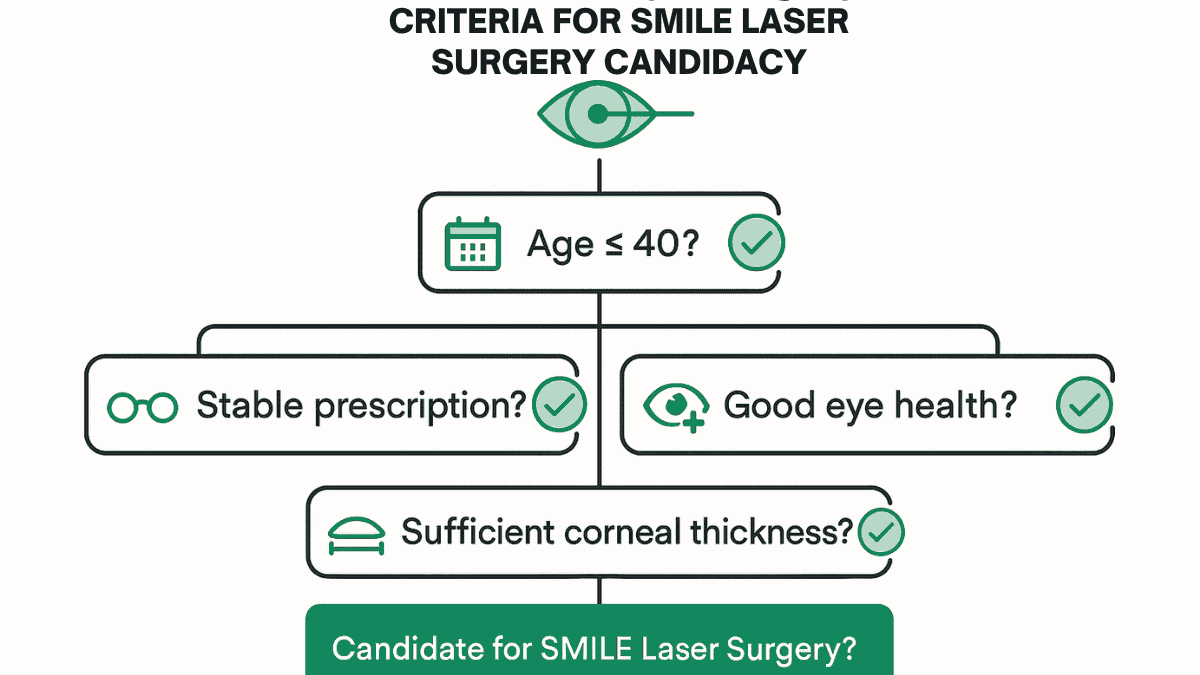
Determining candidacy for SMILE laser eye surgery is a crucial step for anyone exploring vision correction. Not all individuals are suitable for this specific laser eye surgery. Multiple factors are considered, and a comprehensive eye examination by a skilled ophthalmologist is vital.
Typically, SMILE is an excellent option for individuals who wear glasses due to nearsightedness (myopia). The procedure can correct a broad spectrum of myopia. It is also approved to treat astigmatism, particularly when it coexists with nearsightedness.
However, if your primary vision issue is farsightedness (hyperopia), SMILE may not be the recommended laser treatment for you at this time. While research is ongoing, its current application is centered on myopia and associated astigmatism. The effectiveness to treat astigmatism with SMILE has been well documented.
Age is another consideration for smile surgery. Most eye surgeons prefer patients to be at least 18, and often 22 years old. Critically, your vision prescription must be stable, meaning it has not significantly changed for at least one year. Undergoing eye surgery while your vision is still actively changing may not yield long-term stable results.
Corneal Health and Thickness
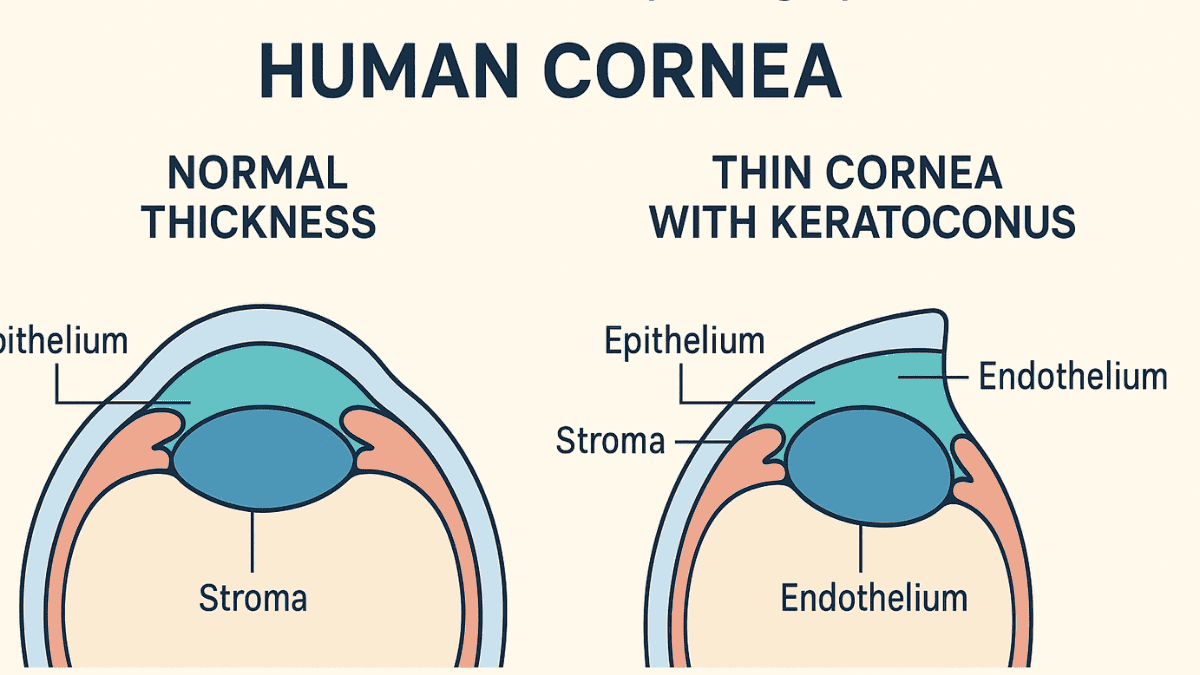
The condition and thickness of your cornea play a pivotal role in determining suitability for SMILE laser eye. The cornea, the transparent front part of your eye, is where the lenticule extraction occurs. Since SMILE involves removing a minute amount of corneal tissue, sufficient initial corneal thickness is necessary for a safe procedure; indeed, making sure the surgery is safe is paramount.
Specific eye conditions affecting the cornea might mean SMILE is not the best choice. For example, keratoconus, an eye disease where the cornea thins and develops a conical bulge, is often a contraindication. Extremely thin corneas could also make this type of corrective eye surgery unsuitable, as maintaining corneal integrity is vital for long-term eye health.
Your general eye health status is thoroughly evaluated. Issues such as severe dry eye, uncontrolled glaucoma, or existing cataracts might need to be managed before considering laser vision correction, or they could make you a less than ideal candidate. Additionally, vision can fluctuate during pregnancy or breastfeeding, so eye surgery is typically deferred until after this period to make sure the results are stable.
To determine if SMILE eye surgery is safe for you, your ophthalmologist will conduct a series of detailed tests. These include precise measurements of your prescription, corneal mapping (topography), eye pressure checks, and an overall assessment of your eye health. This comprehensive evaluation helps your doctor confirm if the SMILE procedure offers a safe and effective path to vision improvement for your specific eye conditions.
Exploring the Benefits of Choosing SMILE
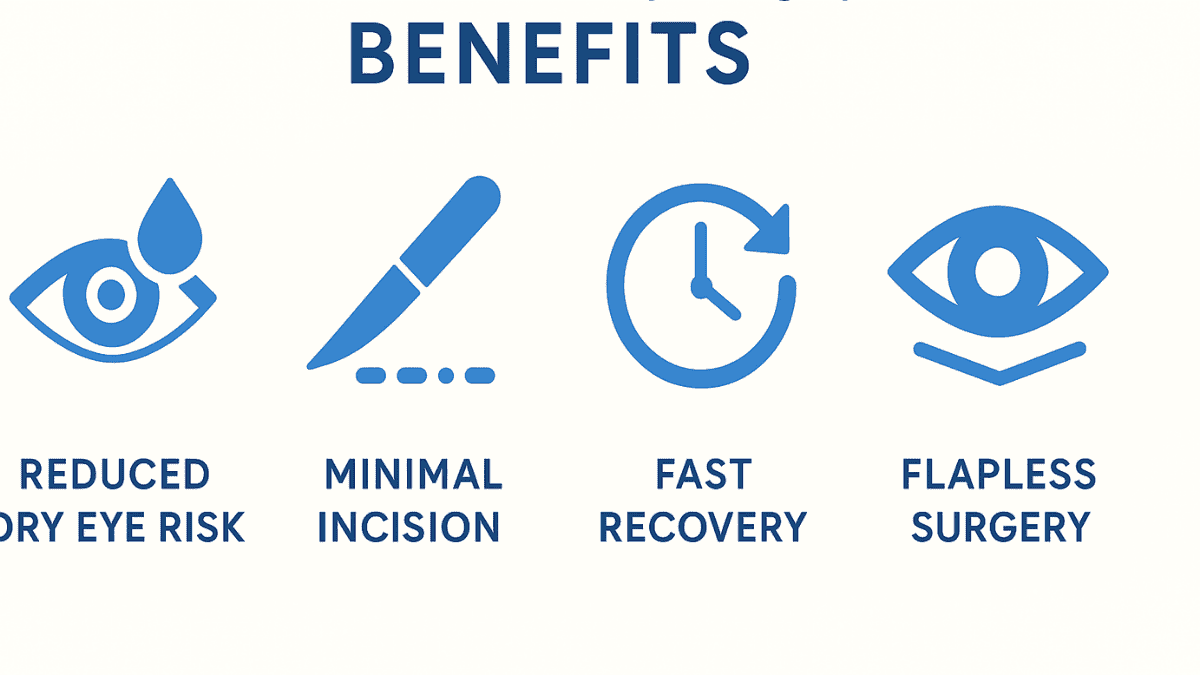
Why do individuals opt for the SMILE laser eye procedure over other available vision correction surgeries? There are several strong advantages. Many patients discover that the benefits of this laser treatment resonate well with their personal preferences and lifestyle needs.
A primary attraction is its minimally invasive characteristic. The small incision central to the SMILE technique results in less disturbance to the corneal surface. This can translate to a smoother recovery experience and potentially a reduced likelihood of certain complications, such as those associated with the corneal flap created in LASIK.
Furthermore, research indicates a generally lower occurrence of post-operative dry eyes with SMILE surgery. This is a considerable benefit, as dry eye symptoms can be a frequent concern after laser vision correction. The small incision in SMILE is thought to affect fewer corneal nerves, thereby diminishing this risk, which is especially important for those already susceptible to dry eyes.
Corneal Strength and Quick Recovery
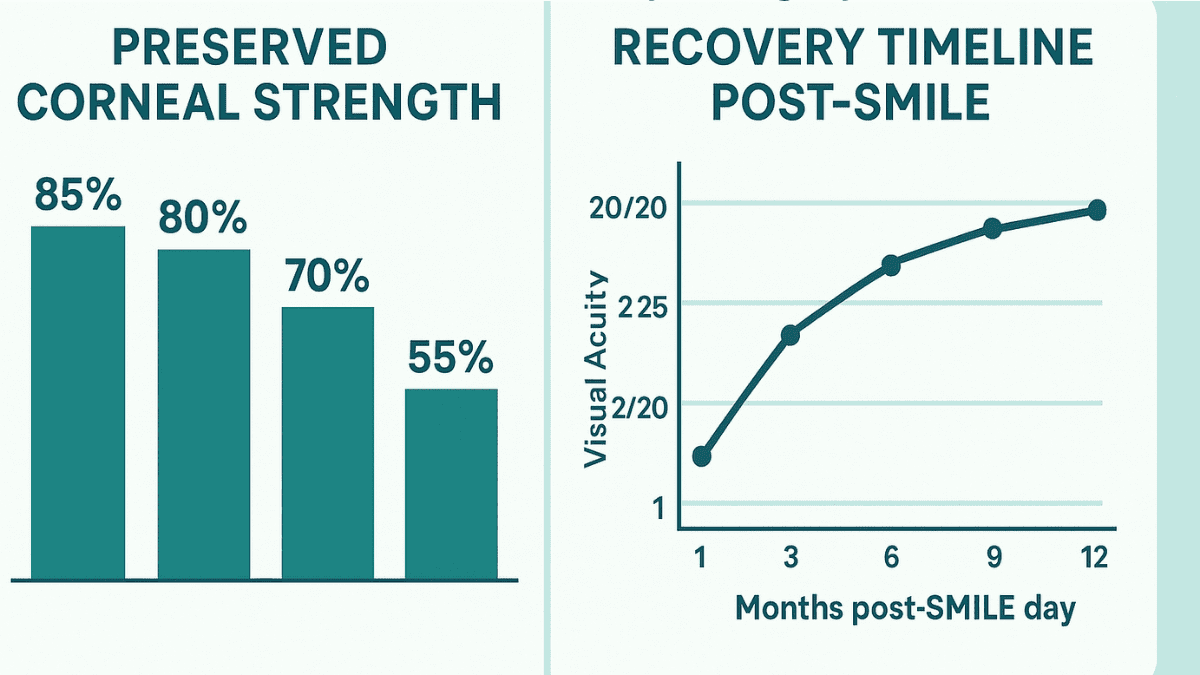
The SMILE laser treatment typically preserves more of the cornea’s structural integrity. This benefit arises because no large flap is created, unlike in some other procedures. The outermost layers of the cornea are largely undisturbed, which can be particularly advantageous for individuals with active lifestyles or those in certain professions where eye safety is a concern.
The recovery time after SMILE eye surgery is often notably swift. Many patients report significant improvement in their vision within just one or two days post-procedure. Some find they can resume most of their regular activities relatively soon, although individual experiences with the healing process can differ.
Additionally, patients frequently describe less discomfort both during and immediately following the smile laser eye surgery. The absence of a large flap created contributes to a generally gentler experience. This can make the prospect of undergoing corrective surgery feel more approachable. These aspects are key reasons why individuals select this advanced laser treatment.
Potential Risks and Side Effects
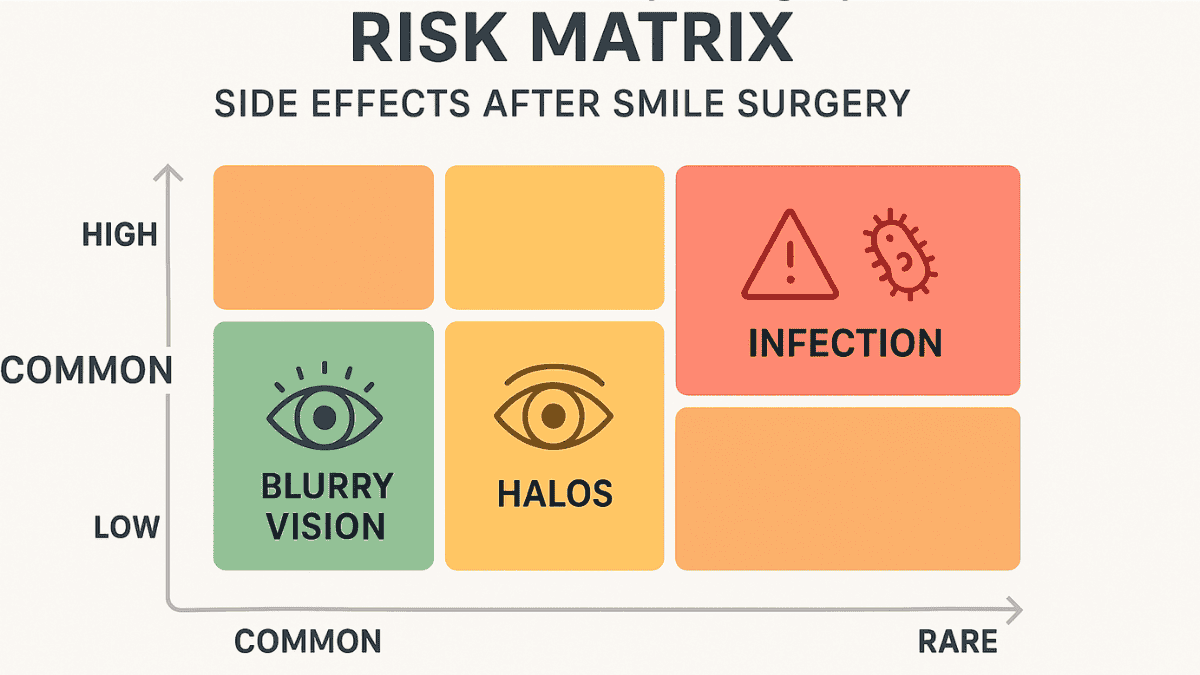
It is vital to approach smile laser eye surgery with realistic expectations. Like any surgical intervention, including smile eye, it carries potential risks. Although serious complications are infrequent, awareness is important, and your surgeon will cover these in detail, as patient safety is a top priority.
Temporary side effects are common during the initial healing process. These can include blurry or hazy vision immediately after the laser eye surgery. Some individuals might notice halos or glare around lights, particularly at nighttime, and light sensitivity can also occur for a brief duration; these typically subside as your eyes heal.
A minor risk of infection or inflammation exists, as with any eye surgery. Adhering strictly to post-operative care guidelines is crucial for minimizing such risks. This includes the diligent use of prescribed eye drops as directed by your medical professionals to support the healing process and protect your eye health.
Less Common Complications
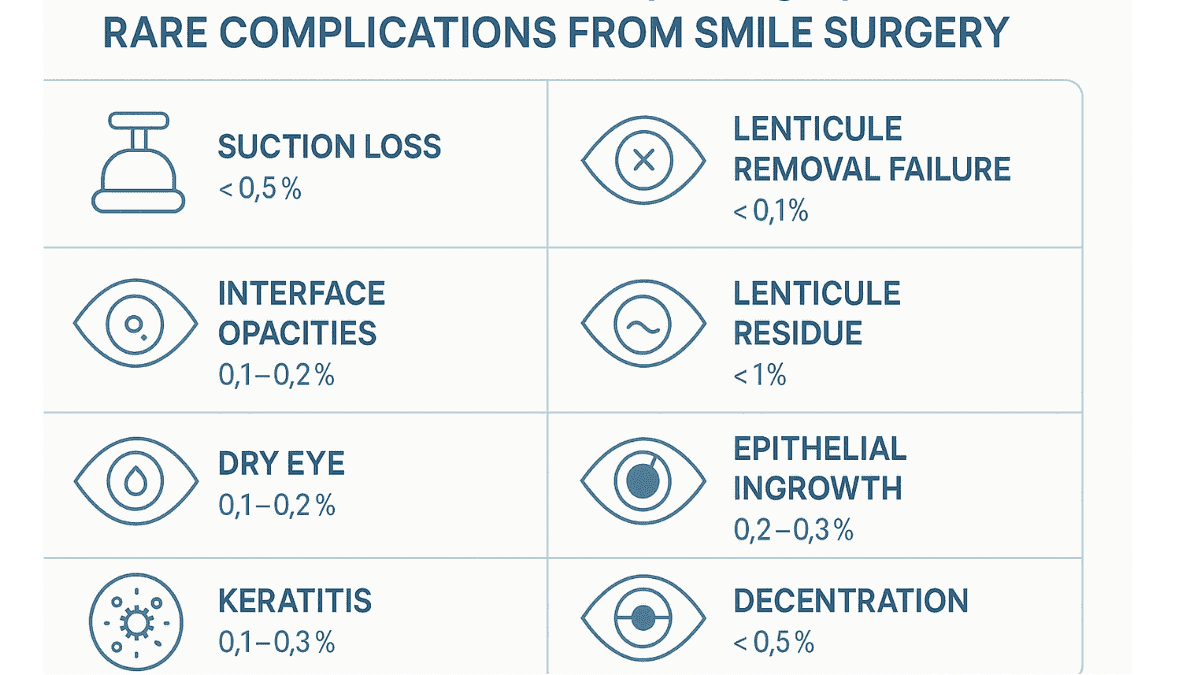
Occasionally, the outcome of the vision correction may not be perfectly aligned with the target, resulting in undercorrection or overcorrection. In such instances, an additional enhancement procedure, another form of corrective surgery, might be considered at a later stage, though this is not a frequent occurrence. The precision of the initial lenticule extraction aims to minimize this.
During the smile procedure itself, there is a minimal risk of intraoperative complications. One such example is suction loss, where the apparatus gently holding the eye in place momentarily loses its hold. Experienced surgeons are adept at managing these situations, which might involve pausing and readjusting or slightly modifying the surgical plan to continue safely.
Challenges in removing the lenticule, or the possibility of minute remnants of the lenticule remaining, can also arise, albeit rarely. These are uncommon scenarios but are discussed as part of the comprehensive informed consent process. Open communication about all potential risks is fundamental before you proceed with smile laser eye surgery or any eye laser treatment.
Your Journey: Before, During, and After SMILE
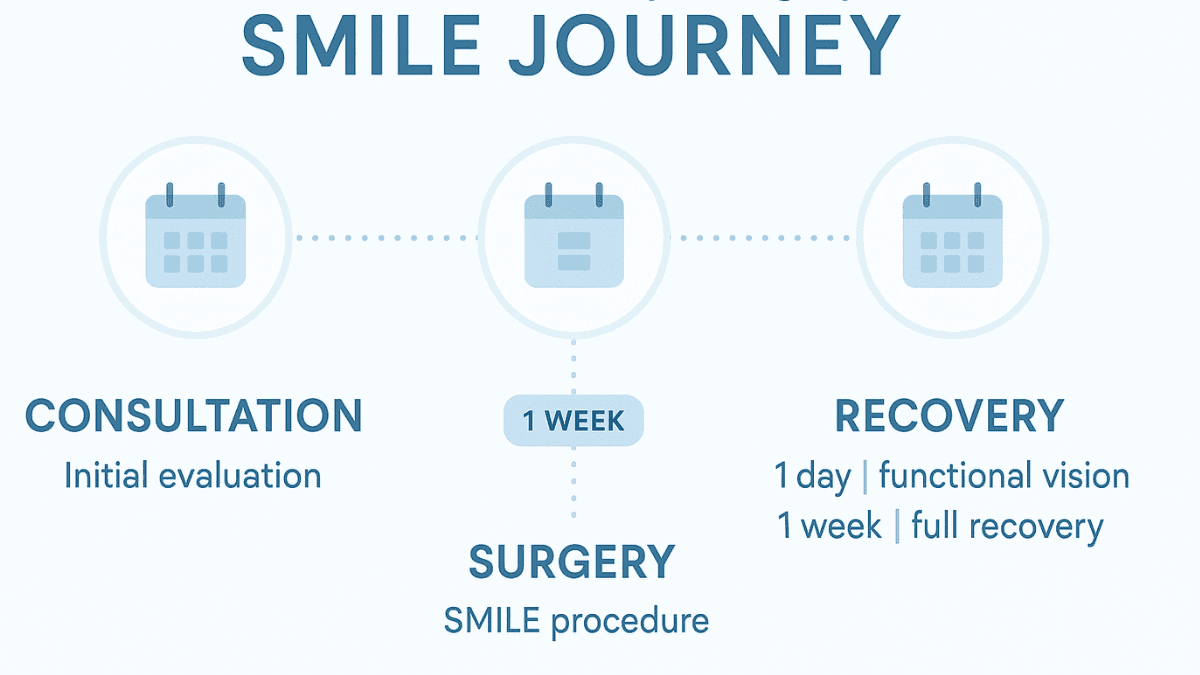
Preparing for Your SMILE Procedure
Your experience with smile laser eye surgery begins with a thorough consultation. This initial appointment involves comprehensive eye examinations conducted by medical professionals. Your doctor will use this information to confirm your suitability for the smile procedure and will discuss all aspects of the surgery, answering any questions you may have.
If you currently wear contact lenses, you will need to discontinue their use for a period before your final pre-operative assessment and the surgery itself. For individuals using soft contact lenses, this period is usually one to two weeks. Those who wear hard or gas permeable contact lenses may need to stop for a longer duration, allowing the cornea to revert to its natural contour.
Arrangements for transportation home on the day of your surgery are necessary, as your vision will be blurry immediately afterward. It is also beneficial to plan for some dedicated rest time following the laser eye surgery. Preparing ahead can make your experience with the smile laser treatment smoother.
The Day of Your SMILE Surgery
On the day of your SMILE surgery, try to remain calm and relaxed. Upon arrival at the eye hospital or clinic, additional eye drops will be administered to numb your eyes completely. The area around your eyes will also be gently cleaned by the surgical team.
You will then recline comfortably under the advanced femtosecond laser system. A small, sterile device will be used to help keep your eyelids open during the brief procedure. You will be instructed to fixate on a target light while the laser performs its work, which, as noted, is very quick.
Following the laser application, the surgeon proceeds with the lenticule extraction. You may sense a mild pressure but should not feel pain. Once the procedure is completed for both eyes, your surgeon will conduct an initial check, provide post-operative care instructions, and prescribe necessary eye drops before you are ready to go home and rest.
Recovery and Post-Operative Care
The initial recovery time after smile laser eye surgery involves some expected symptoms. Your vision may be somewhat blurry in the first few hours, and your eyes might feel slightly gritty or watery. Resting with your eyes closed is recommended, and many patients find a nap beneficial during this early healing process.
A follow-up appointment is typically scheduled for the day after your smile eye surgery. During this visit, your surgeon will assess your vision and check your general eye health. You will be required to use prescribed antibiotic and anti-inflammatory eye drops regularly; these are critical for promoting healing and preventing potential infections.
Certain activity restrictions will be in place temporarily. It’s important to avoid eye rubbing to protect the healing cornea. You should also avoid water from swimming pools and hot tubs for a specified period, and steer clear of dusty or smoky environments. Strenuous exercise should be postponed for about the first week, and you should take care to avoid water splashing directly into your eyes when showering. Your vision will progressively improve and stabilize over the subsequent weeks, with most individuals experiencing substantial visual gains quite rapidly.
SMILE vs. LASIK vs. PRK: A Quick Comparison
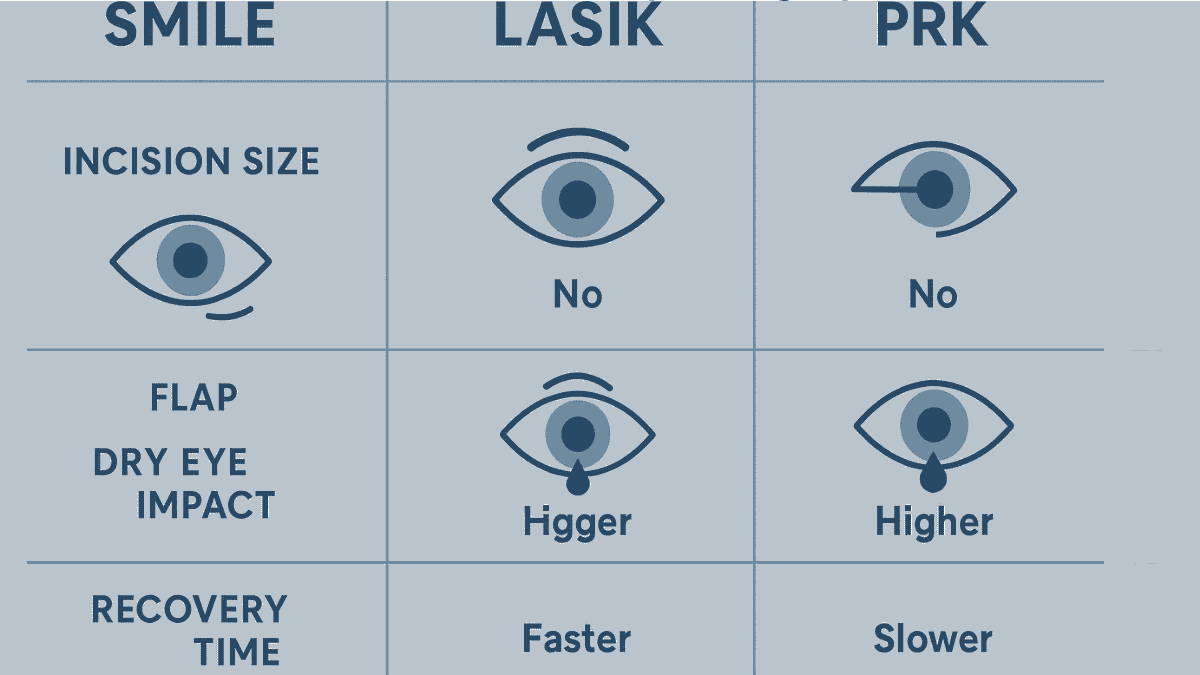
Understanding how SMILE compares to other common types of refractive surgery can aid your decision-making. LASIK (Laser-Assisted In Situ Keratomileusis) and PRK (Photorefractive Keratectomy) are widely recognized laser vision correction techniques. Each method of laser eye surgery has its own set of advantages and disadvantages.
| Feature | SMILE | LASIK | PRK |
|---|---|---|---|
| Incision Size | Very Small (2-4mm) | Larger Flap Incision | No Incision (Epithelium Removed) |
| Corneal Flap | No Flap | Yes, a Flap is Created | No Flap |
| Dry Eye Incidence | Generally Lower | Can be Higher | Can be Higher initially |
| Corneal Nerve Impact | Less Impact | More Impact | Moderate Impact |
| Typical Visual Recovery | Often Rapid (1-2 days) | Usually Very Rapid (within 24hrs) | Slower (several days to weeks) |
| Suitable For | Nearsightedness, Astigmatism | Nearsightedness, Farsightedness, Astigmatism | Nearsightedness, Farsightedness, Astigmatism (often good for thinner corneas) |
The defining characteristic of SMILE, particularly the small incision lenticule extraction smile technique, is the tiny incision and absence of a corneal flap. This aspect is believed to contribute to its advantages concerning dry eye symptoms and the preservation of corneal strength. LASIK, on the other hand, is known for very rapid visual recovery and its ability to treat a wider array of refractive errors, including farsightedness, as well as myopia and astigmatism.
PRK, another type of laser eye, completely avoids creating a flap by gently removing the cornea’s outermost cellular layer (the epithelium), which then regenerates. This approach might be more suitable for individuals with thinner corneas or those in specific professions or activities where flap displacement is a concern. However, PRK’s recovery period is typically longer and can involve more discomfort compared to SMILE or LASIK. Your ophthalmologist will help determine the most appropriate corrective surgery for your individual eye conditions and visual goals.
Considering the Cost of SMILE Laser Eye Surgery
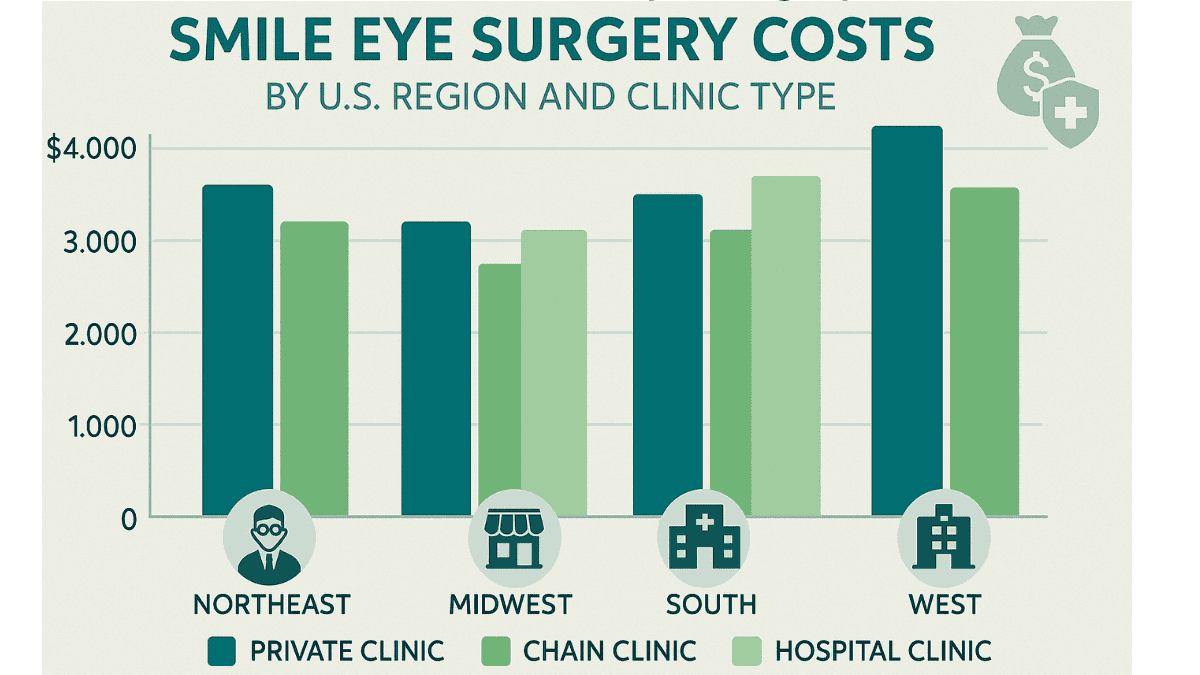
The surgery costs associated with SMILE laser eye surgery are a practical and significant consideration for many. This laser eye procedure is frequently seen as a valuable investment in one’s vision and quality of life. Prices for SMILE surgery can differ substantially based on a variety of factors.
Elements such as the surgeon’s level of experience and professional standing contribute to the overall cost. The specific laser technology employed at the eye hospital or clinic also plays a part. Geographic location of the practice can influence pricing, and it is important to understand what is encompassed in the quoted price; some comprehensive packages include all pre-operative evaluations and post-operative follow-up appointments.
Typically, laser vision correction, including the SMILE procedure, is classified as an elective surgery. Consequently, medical insurance plans usually do not provide coverage for the surgery costs. However, it is always recommended to review your individual insurance policy details, as some vision-specific plans might offer a partial discount.
Many eye care centers provide financial assistance options to help make the procedure more accessible. These can include payment plans or partnerships with companies that specialize in medical financing. Inquiring about these possibilities at your chosen clinic is a good step. When evaluating the expense, consider it against the potential long-term savings from no longer needing to purchase or wear glasses or a contact lens.
Choosing Your SMILE Surgeon and Clinic
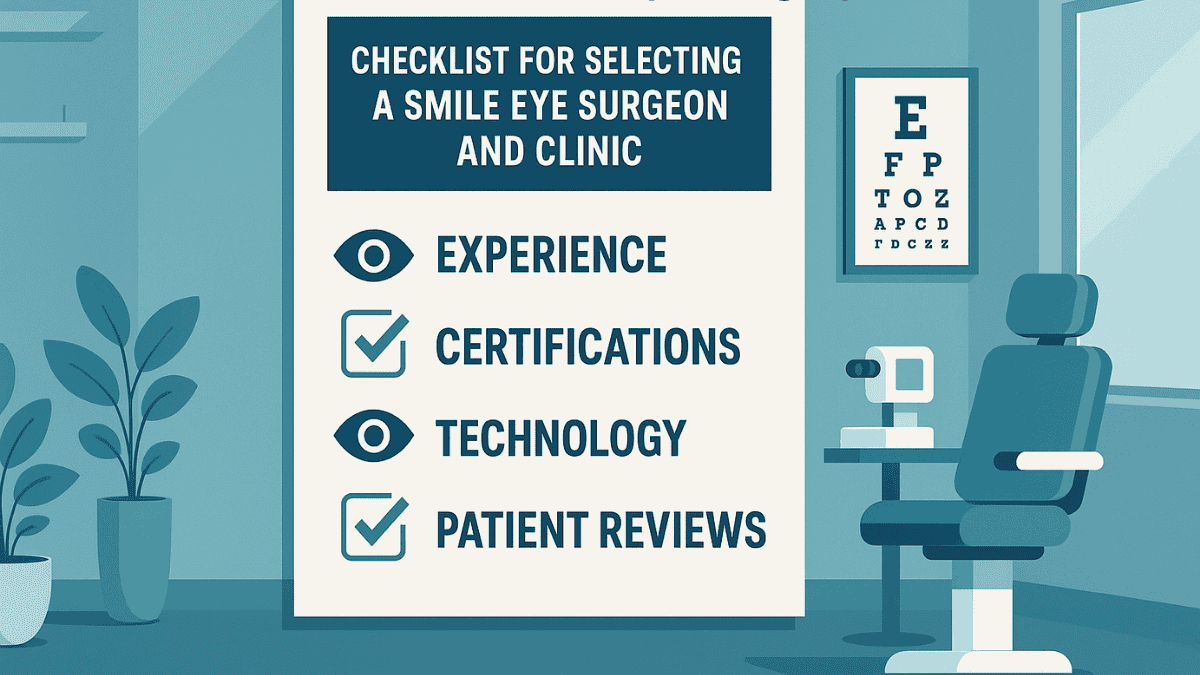
Choosing the right surgeon and clinic for your SMILE laser eye surgery is arguably the most vital step in your journey. This decision should not be hurried; your confidence and comfort are paramount. Thorough research is essential when selecting your medical professionals.
Seek out a surgeon who has substantial experience specifically with the ReLEx SMILE or Smile Pro procedure. Inquire about the number of SMILE eye surgeries they have performed. Always verify their credentials, board certifications, and affiliations with reputable eye hospital networks or vision eye institutes. A trustworthy surgeon will be open about their expertise and outcomes.
The technology utilized is also a key factor. Confirm that the clinic employs current, approved femtosecond laser technology specifically for the SMILE procedure. Patient reviews and testimonials can offer valuable perspectives on others’ experiences with both the surgeon and the clinic’s overall service. Renowned institutions like the Cleveland Clinic often set high standards for patient care and surgical excellence, which can be a benchmark for what to look for in a provider.
Your sense of ease during the initial consultation serves as a good gauge. Were all your questions addressed clearly and patiently? Did you feel respected and not pressured? A quality clinic focuses on comprehensive patient education and supportive care. Obtaining a second opinion is perfectly acceptable if you have any reservations or unanswered questions.
Long-Term Outlook After SMILE
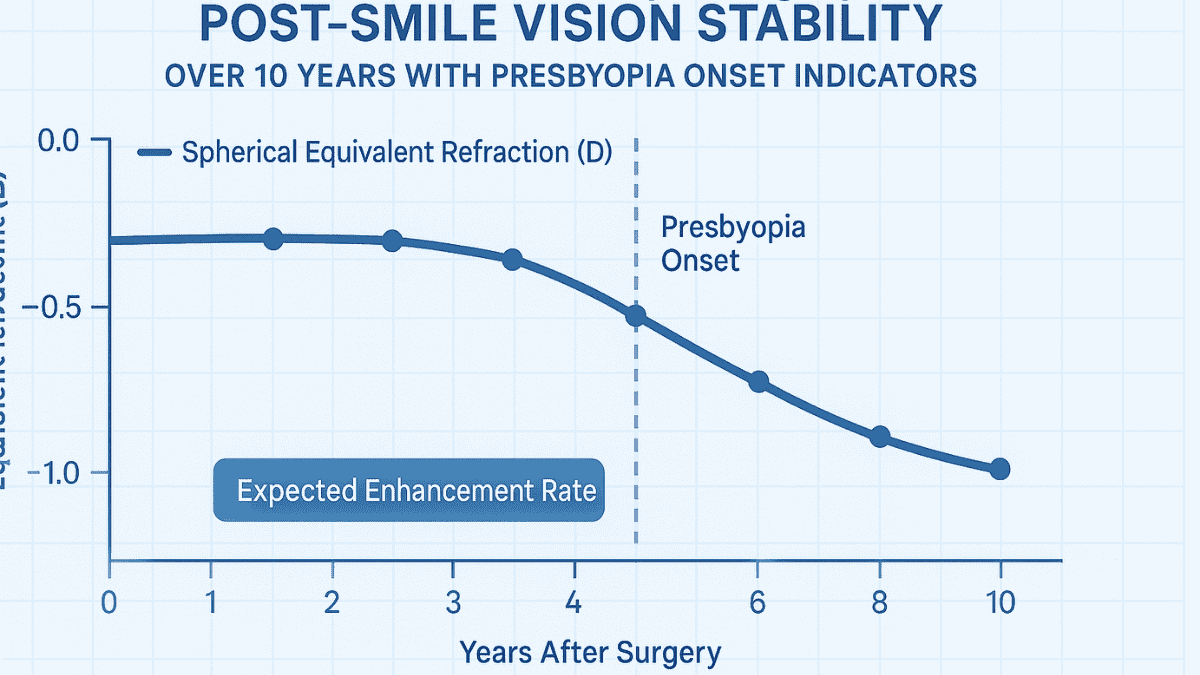
What is the long-term outlook following SMILE laser eye surgery? For the majority of individuals, the visual improvements achieved are stable and enduring. The primary objective of this corrective surgery is to significantly lessen or completely eliminate reliance on glasses or contact lenses.
It is crucial to understand that while SMILE corrects your existing refractive error, it does not halt the natural aging process of the eyes. An age-related change called presbyopia, which is the gradual loss of close-up focusing ability, typically begins to affect people in their 40s. Therefore, if you undergo SMILE surgery in your 20s or 30s, you will likely still require reading glasses for near tasks once presbyopia develops; this is a universal age-related change.
The necessity for an enhancement procedure, or a “touch-up,” years after the initial SMILE surgery is not common. However, it remains a possibility if a significant change in vision occurs later in life. Consistent, regular eye check-ups remain essential for monitoring your overall eye health and vision stability throughout the years. Maintaining good general eye care practices is also beneficial.
Conclusion
Choosing vision correction is a significant personal decision. Gaining knowledge about advanced options like SMILE laser eye surgery, including Small Incision Lenticule Extraction (SMILE), empowers you to make a well-informed choice regarding your eye health. The minimally invasive surgery, with its potential for reduced dry eye symptoms and quick recovery time, makes SMILE eye an appealing laser treatment for many individuals seeking freedom from contact lenses or glasses.
However, it is not a universal solution for all eye conditions. A comprehensive consultation with an experienced eye surgeon specializing in refractive surgery is indispensable. They will evaluate your specific eye structure, discuss your vision aspirations, and determine if SMILE laser eye is the most suitable and safe procedure for you.
The prospect of experiencing life with enhanced clarity, unburdened by the daily use of corrective eyewear, is truly exciting. Modern laser eye surgery techniques like the SMILE procedure are increasingly making this a tangible reality for people around the world. Carefully consider all the provided information, ask your medical professionals pertinent questions, and select the vision correction path that aligns best with your individual needs and eye health.
FAQ
SMILE stands for Small Incision Lenticule Extraction, a minimally invasive laser procedure used to correct myopia and astigmatism.
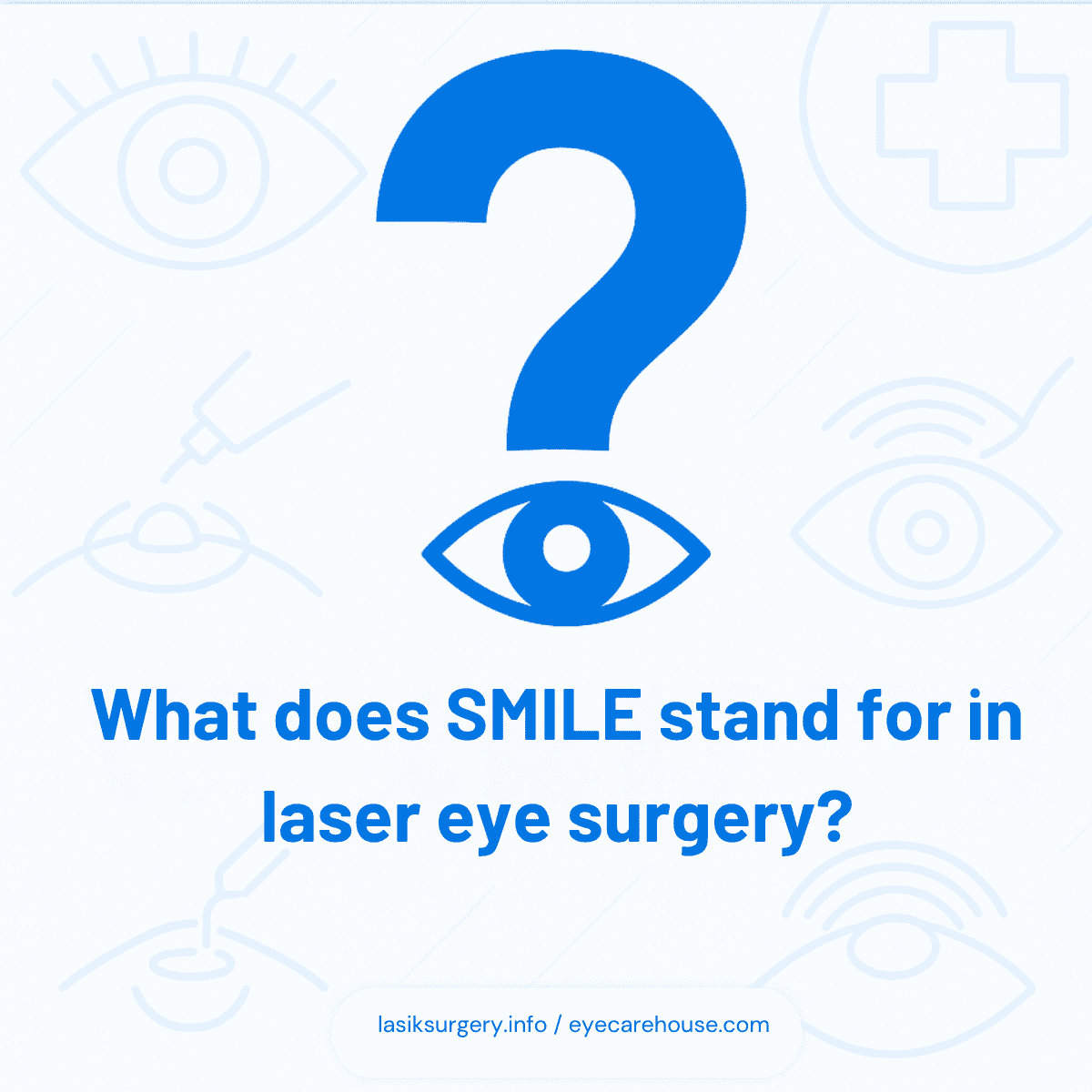
Unlike LASIK, SMILE does not involve creating a large corneal flap. Instead, it uses a small incision to remove a lenticule, reducing dry eye risk and preserving corneal strength.
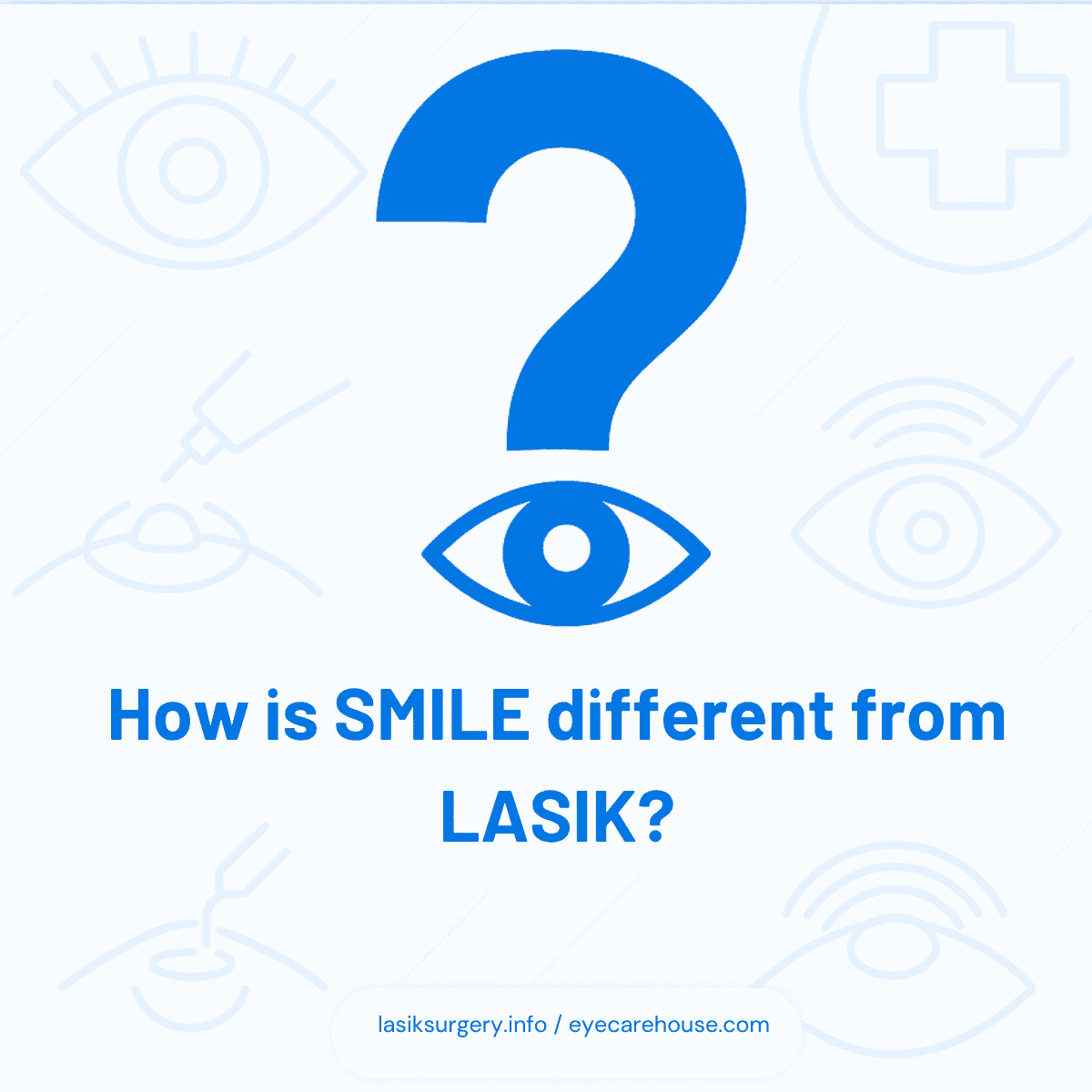
No, SMILE is not painful. Patients receive numbing eye drops before the procedure, and most report only slight pressure during the process.
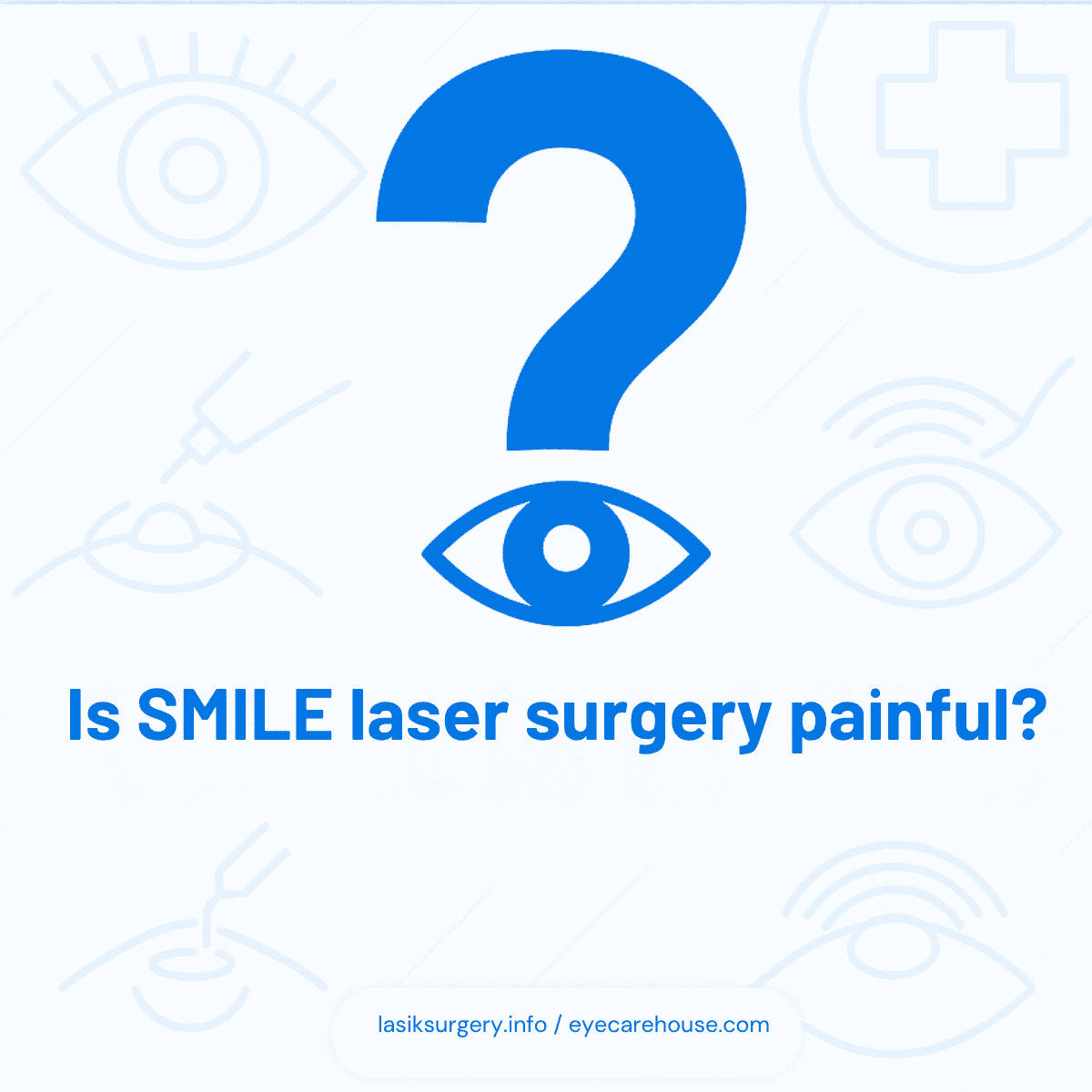
Candidates are typically over 18 with stable prescriptions for myopia or astigmatism, sufficient corneal thickness, and good overall eye health.
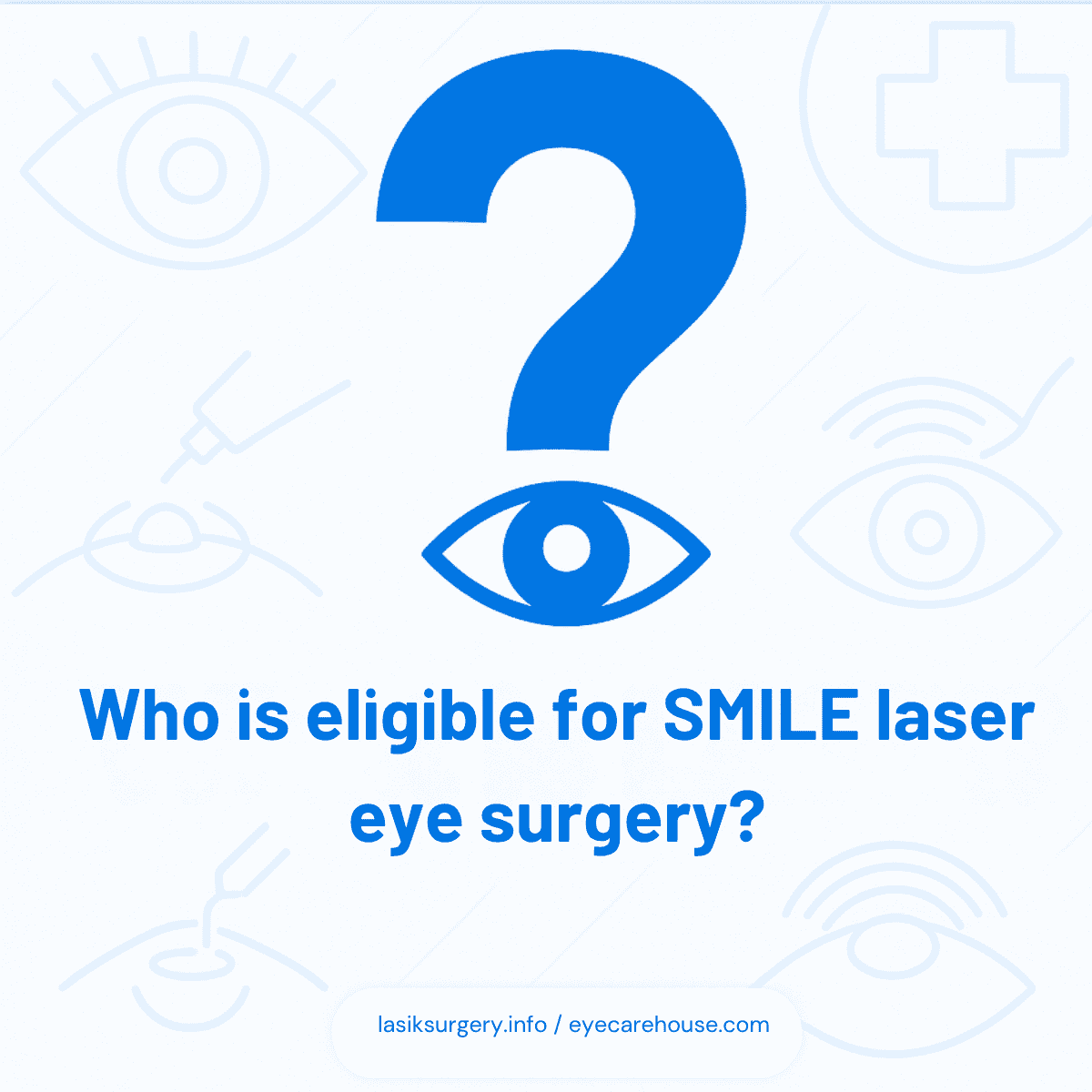
The entire procedure usually takes less than 30 minutes for both eyes, with laser time often under 30 seconds per eye.
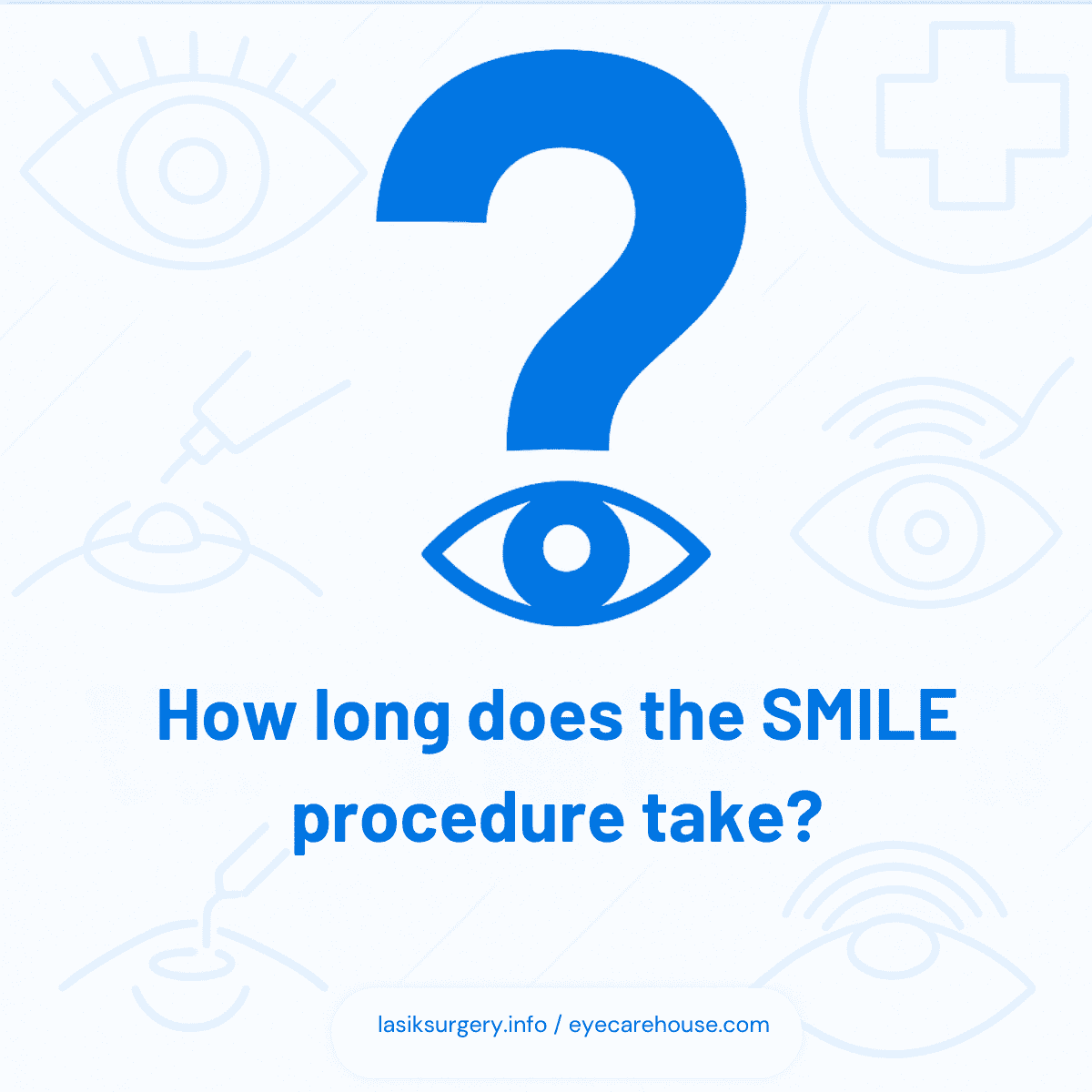
Most patients experience significant vision improvement within 1–2 days and return to normal activities shortly after, with full recovery in a few weeks.
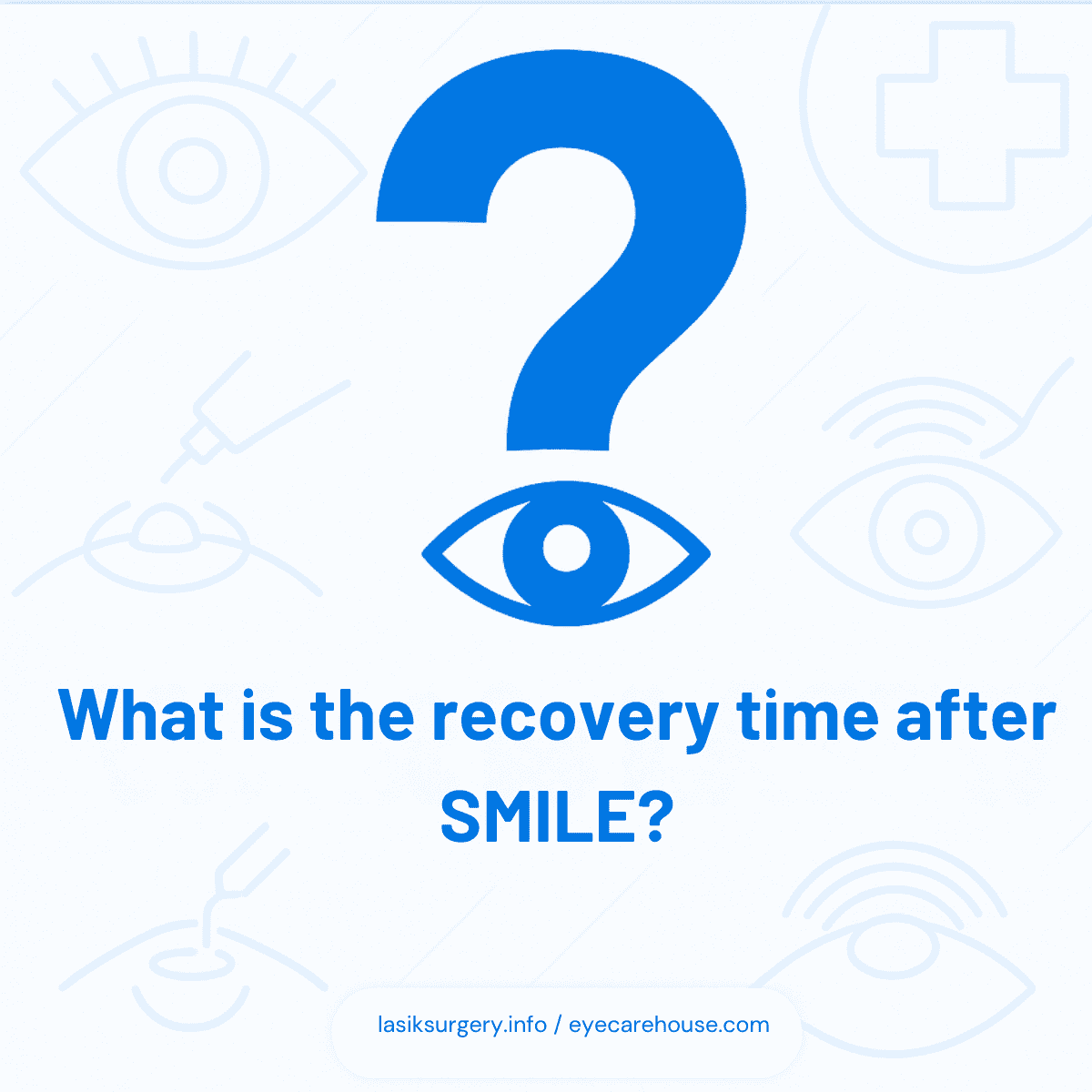
Yes, SMILE is FDA-approved to treat astigmatism alongside nearsightedness, offering improved clarity for eligible patients.
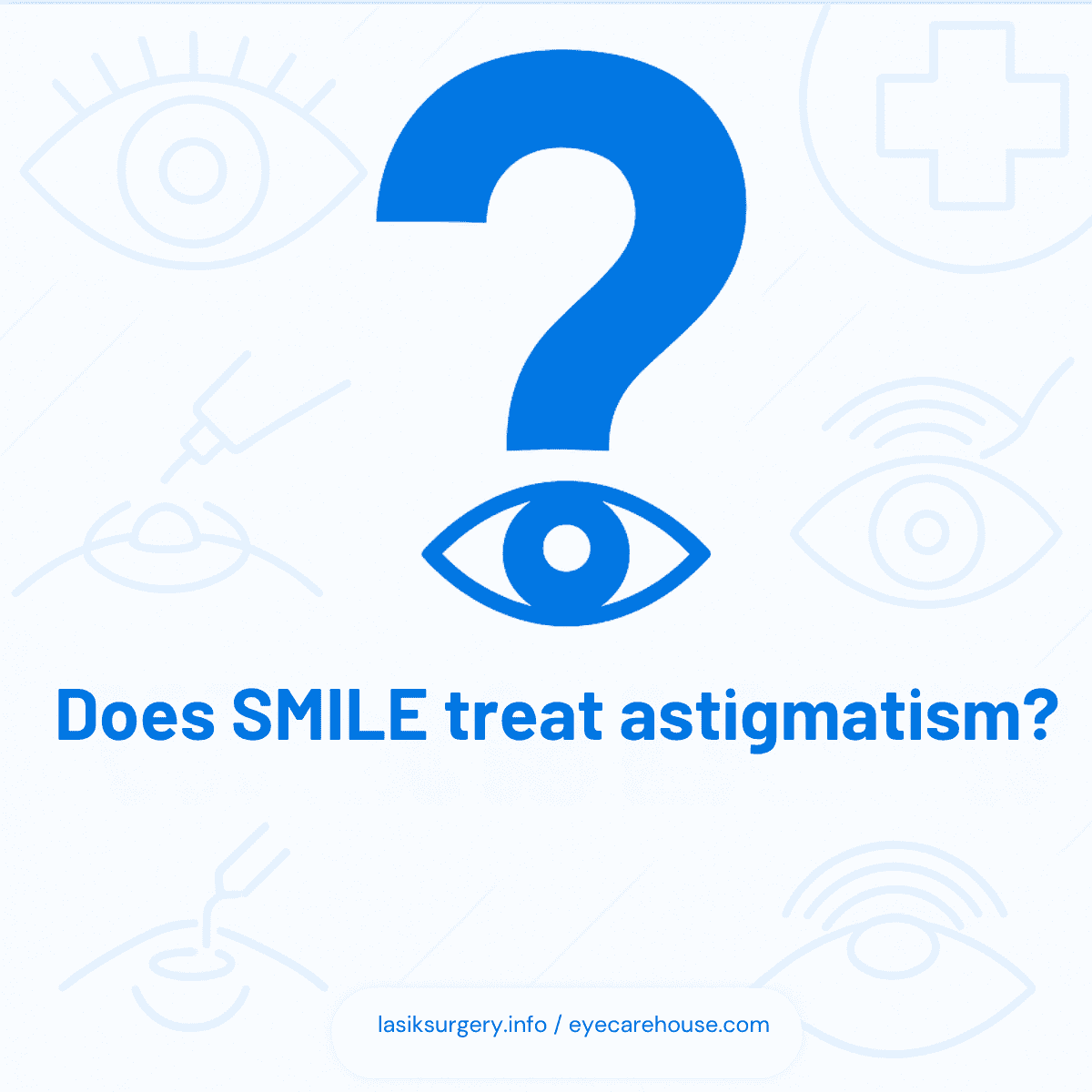
Currently, SMILE is primarily used for nearsightedness and astigmatism. It is not widely approved for farsightedness at this time.
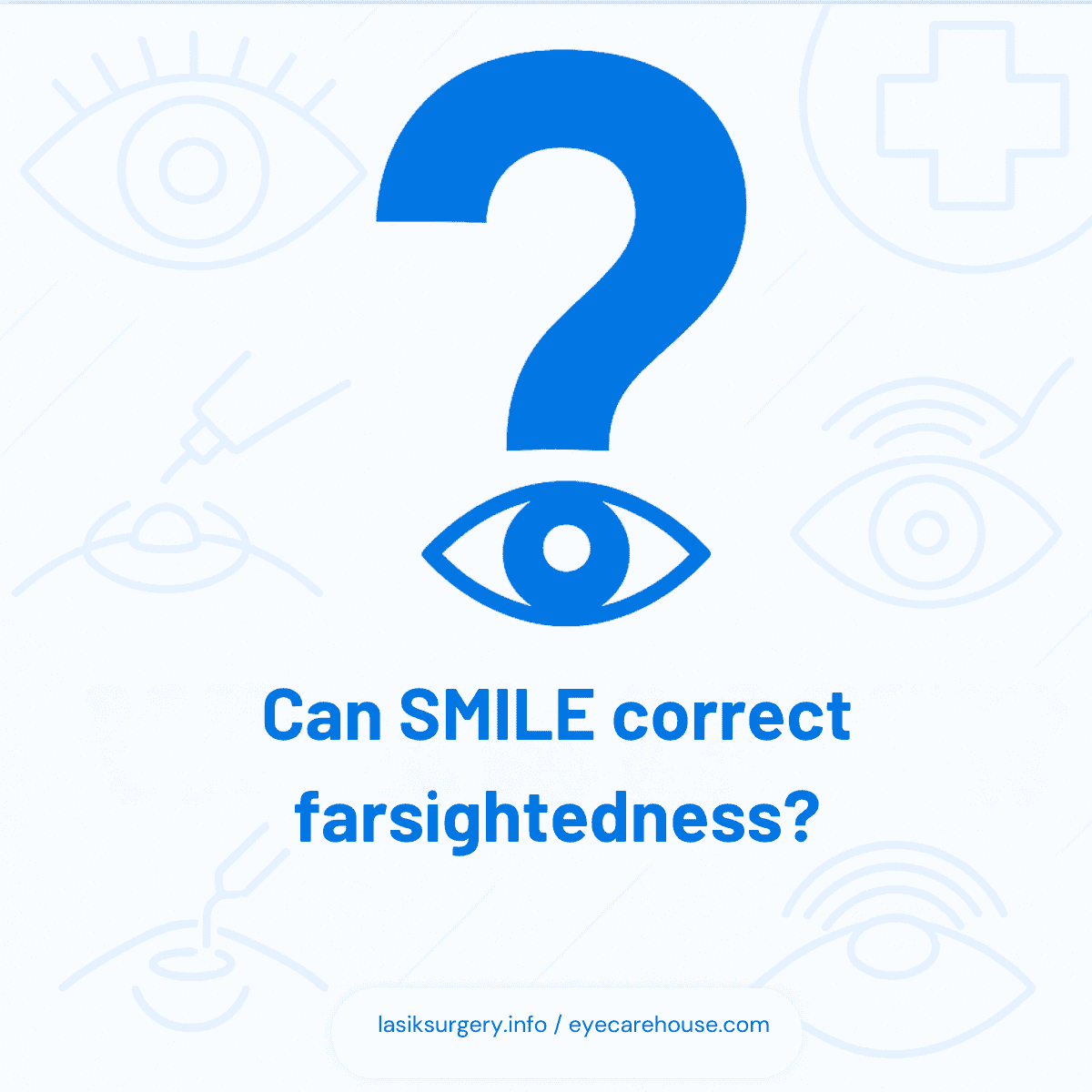
Like all surgeries, SMILE has risks, including temporary dry eyes, halos, or undercorrection. Serious complications are rare with experienced surgeons.
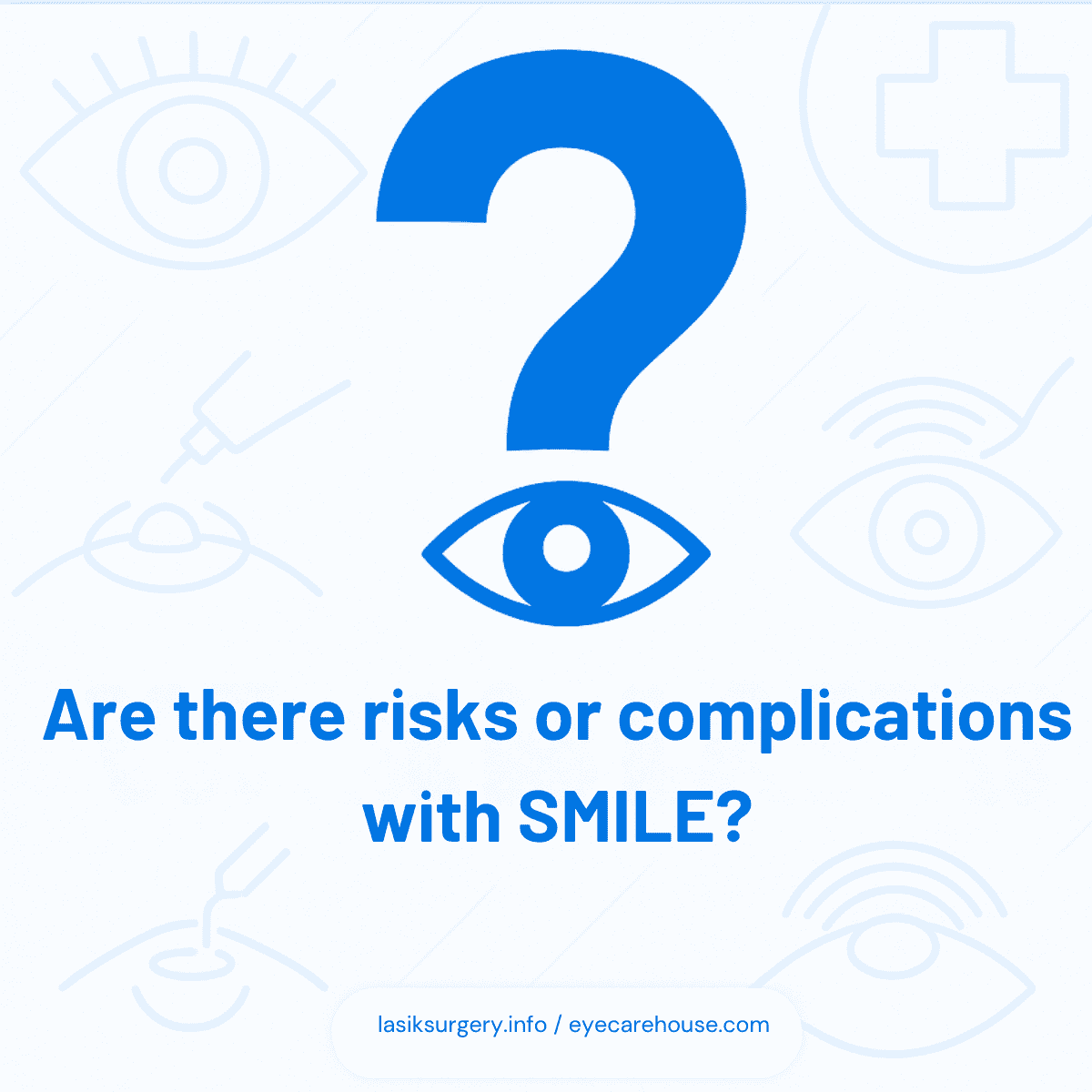
Most patients do not need glasses for distance vision after SMILE, but reading glasses may still be necessary due to age-related presbyopia.
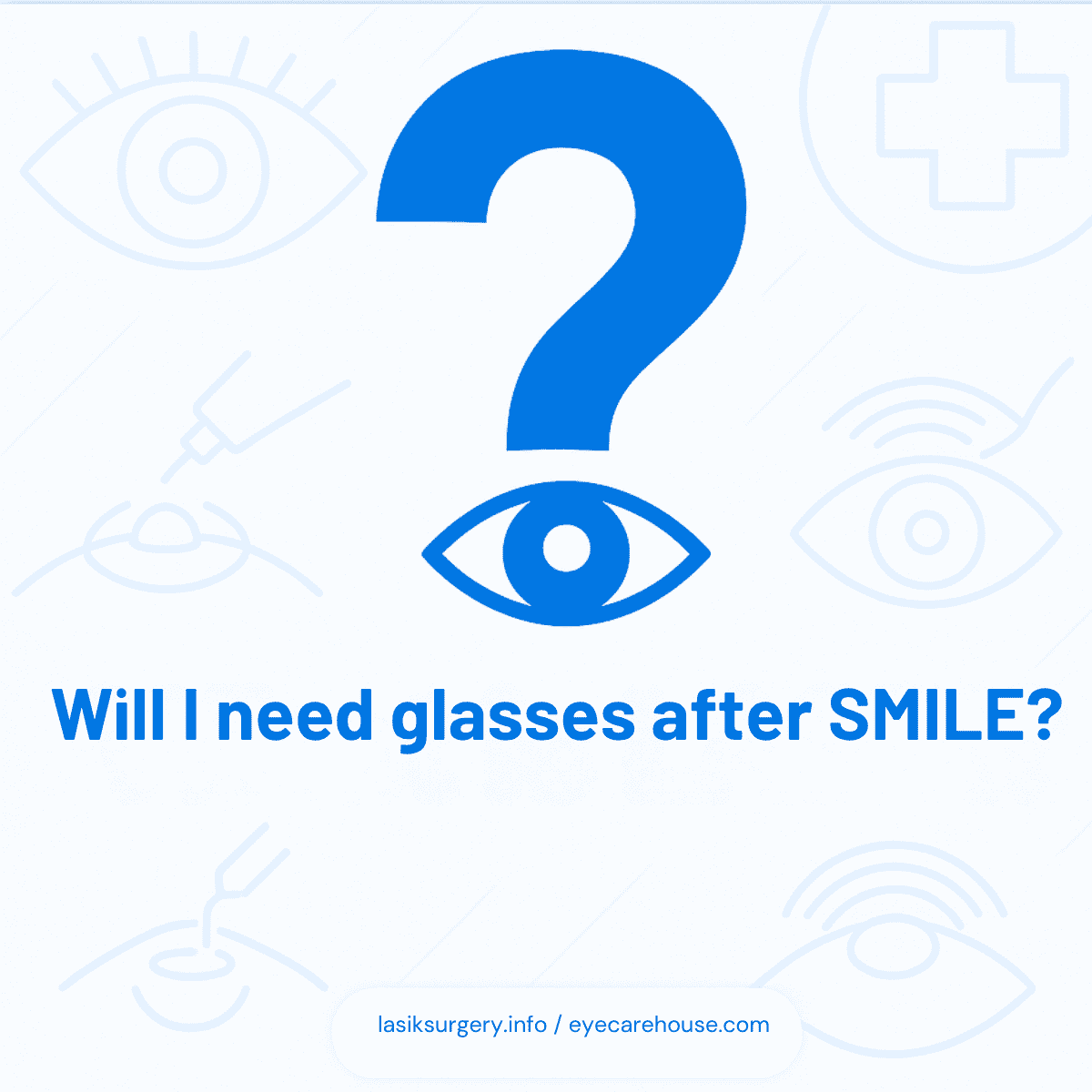
Yes, SMILE is a safe, FDA-approved procedure with a strong safety profile and high success rates when performed by trained ophthalmologists.
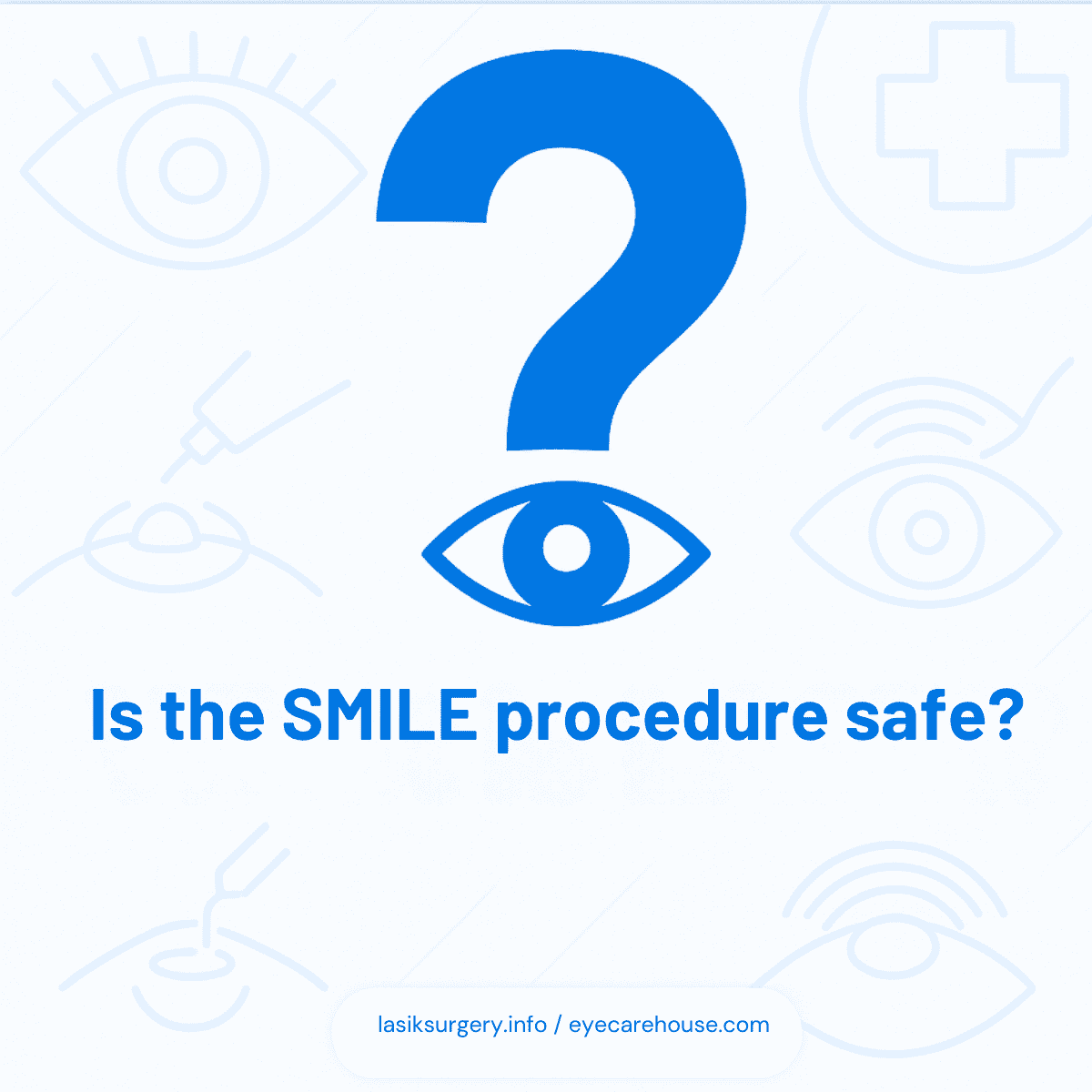
SMILE removes a small, lens-shaped piece of tissue (lenticule) from within the cornea, preserving more surface tissue compared to LASIK.
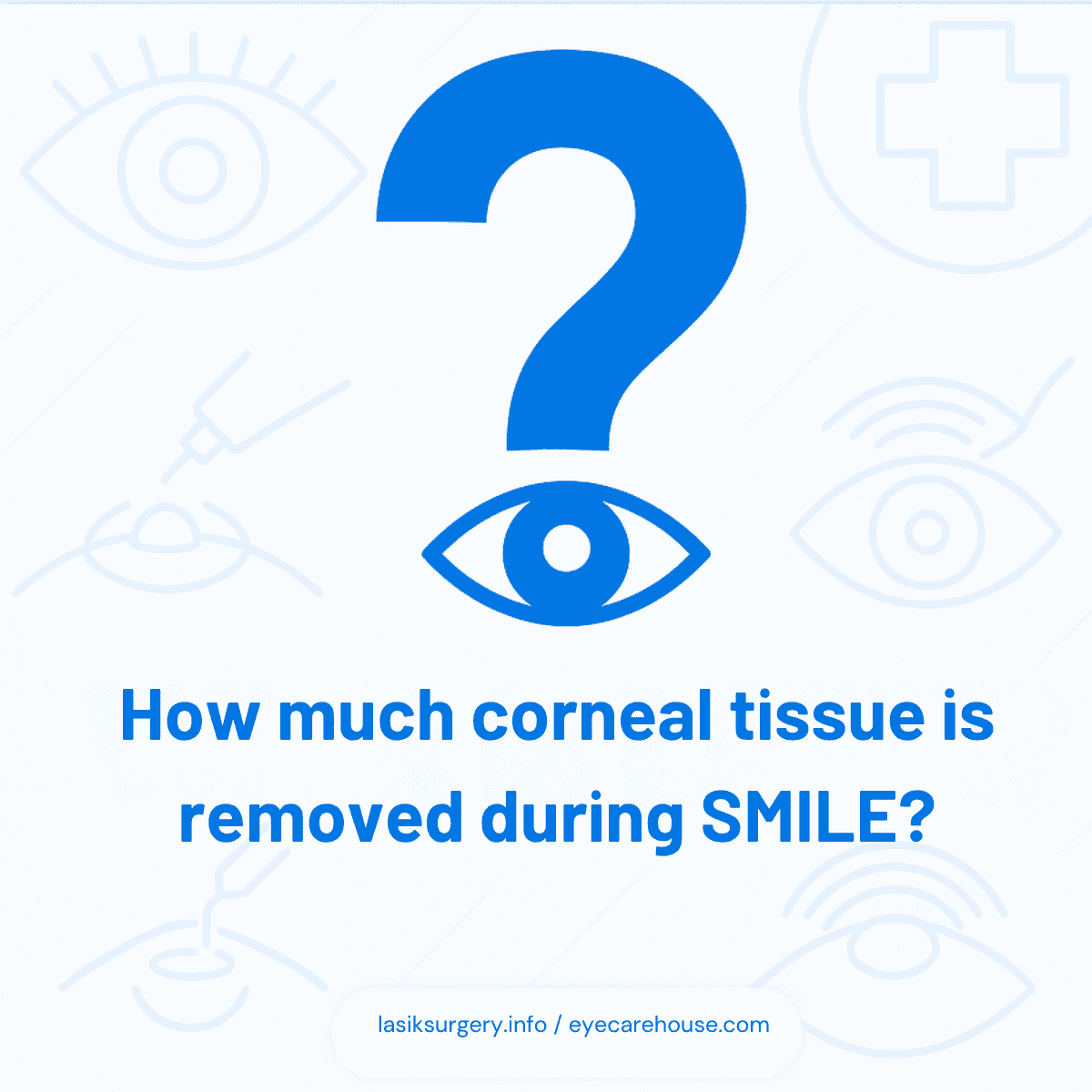
Yes, SMILE is typically performed on both eyes during the same session to ensure balanced recovery and vision correction.
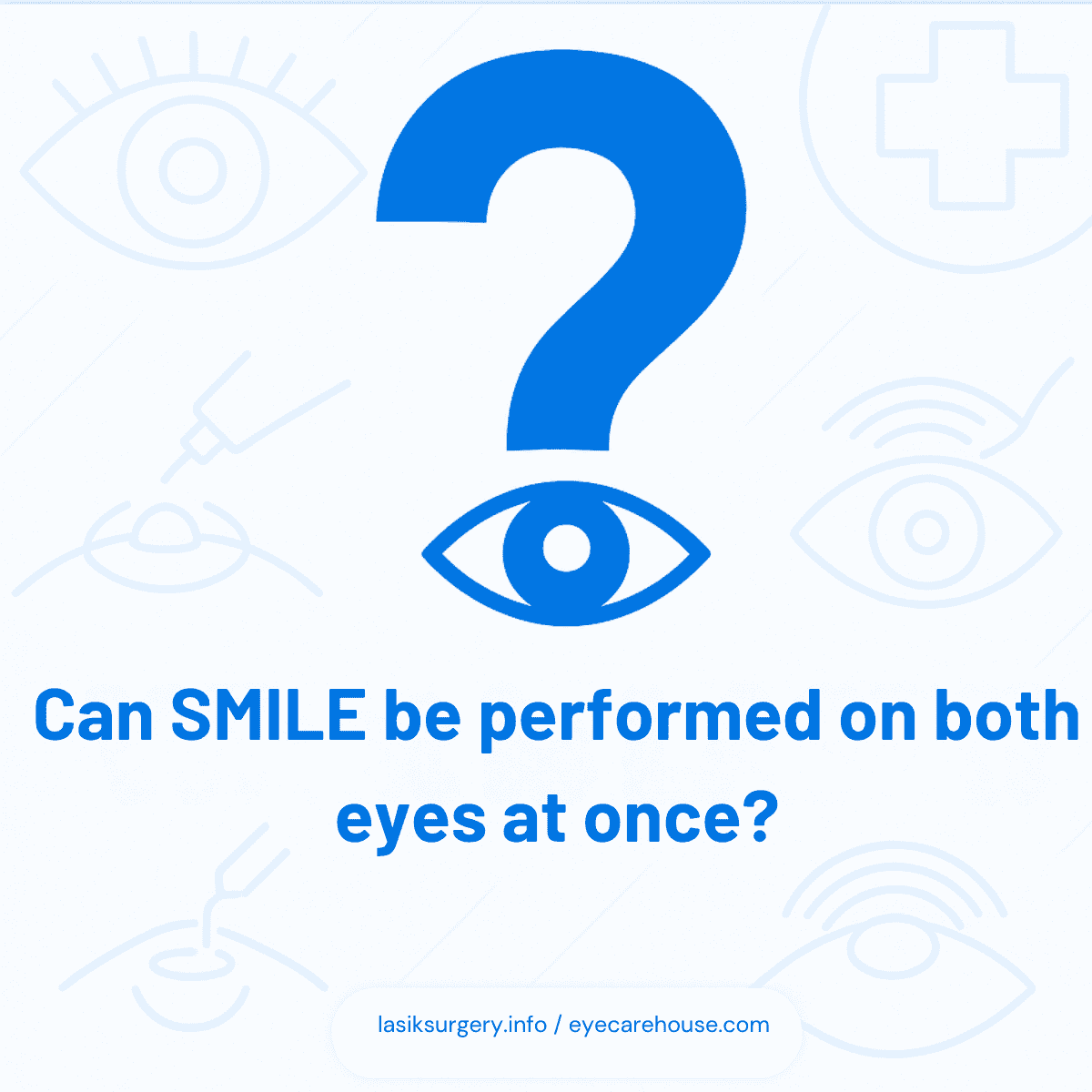
Patients should be at least 18–22 years old with stable vision. There’s no upper age limit, but suitability is based on eye health.
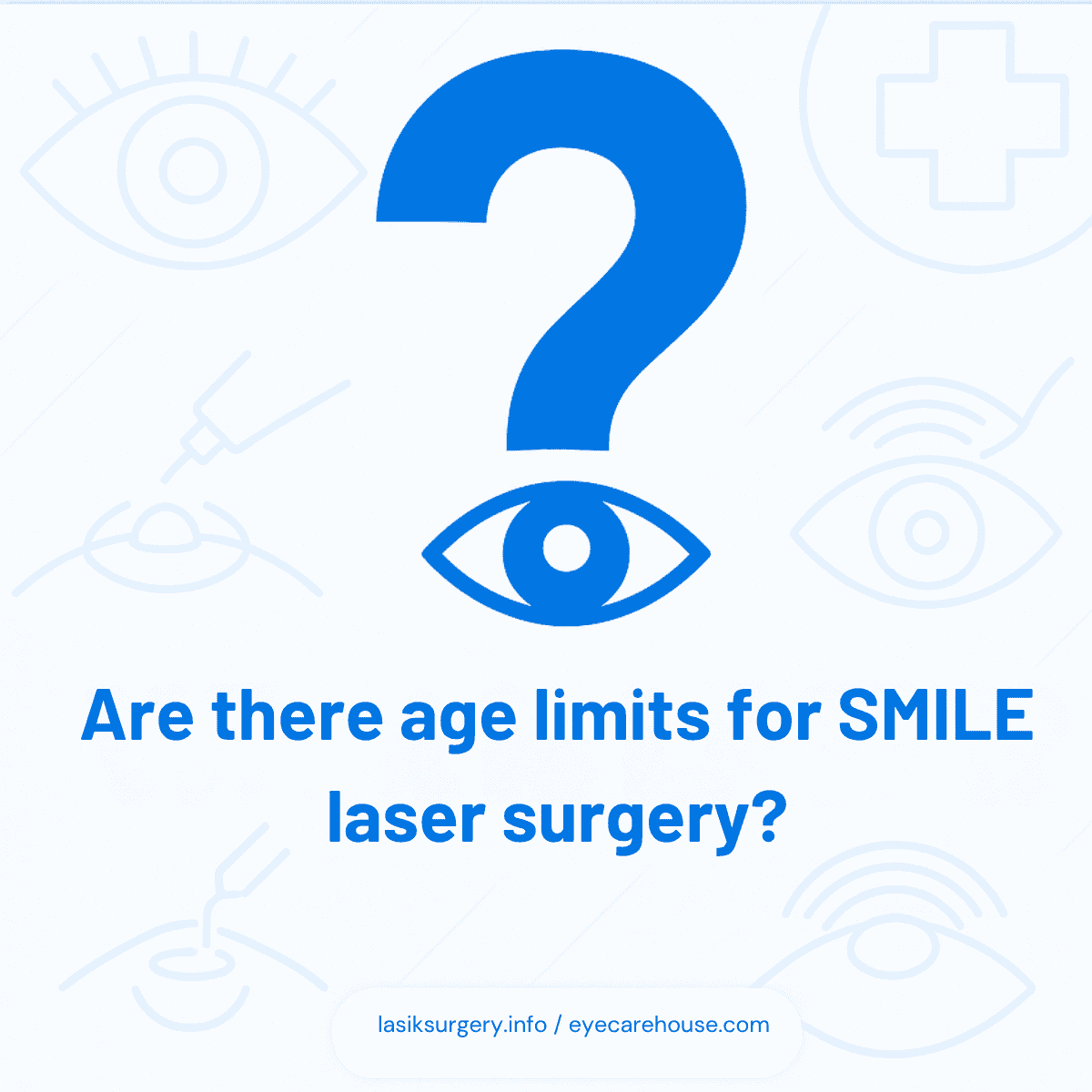
Avoid contact lenses for a few days or weeks before surgery, and arrange transportation. Follow your doctor’s instructions for optimal outcomes.
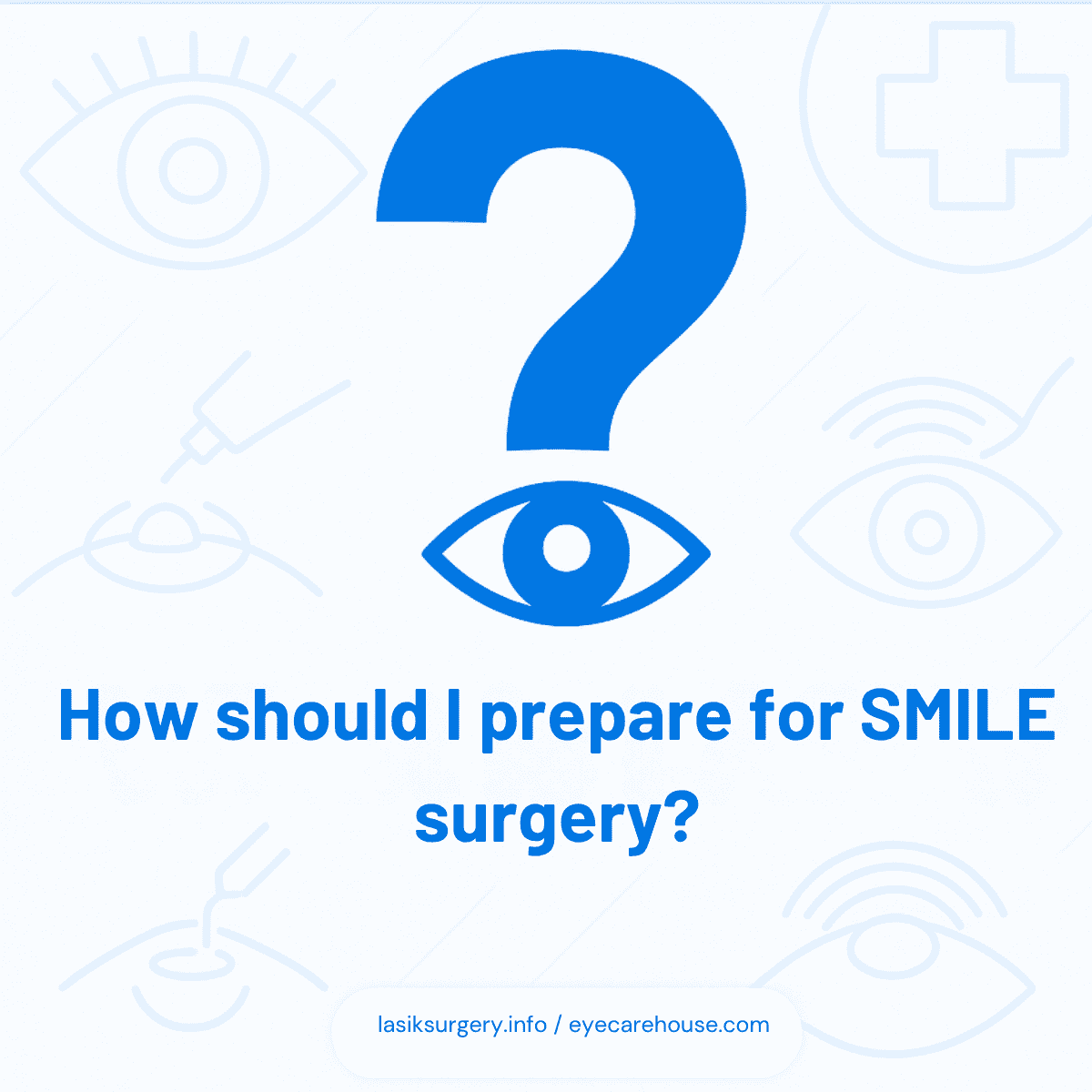
Blindness from SMILE is extremely rare. With proper care and an experienced surgeon, the risk of severe vision loss is very low.
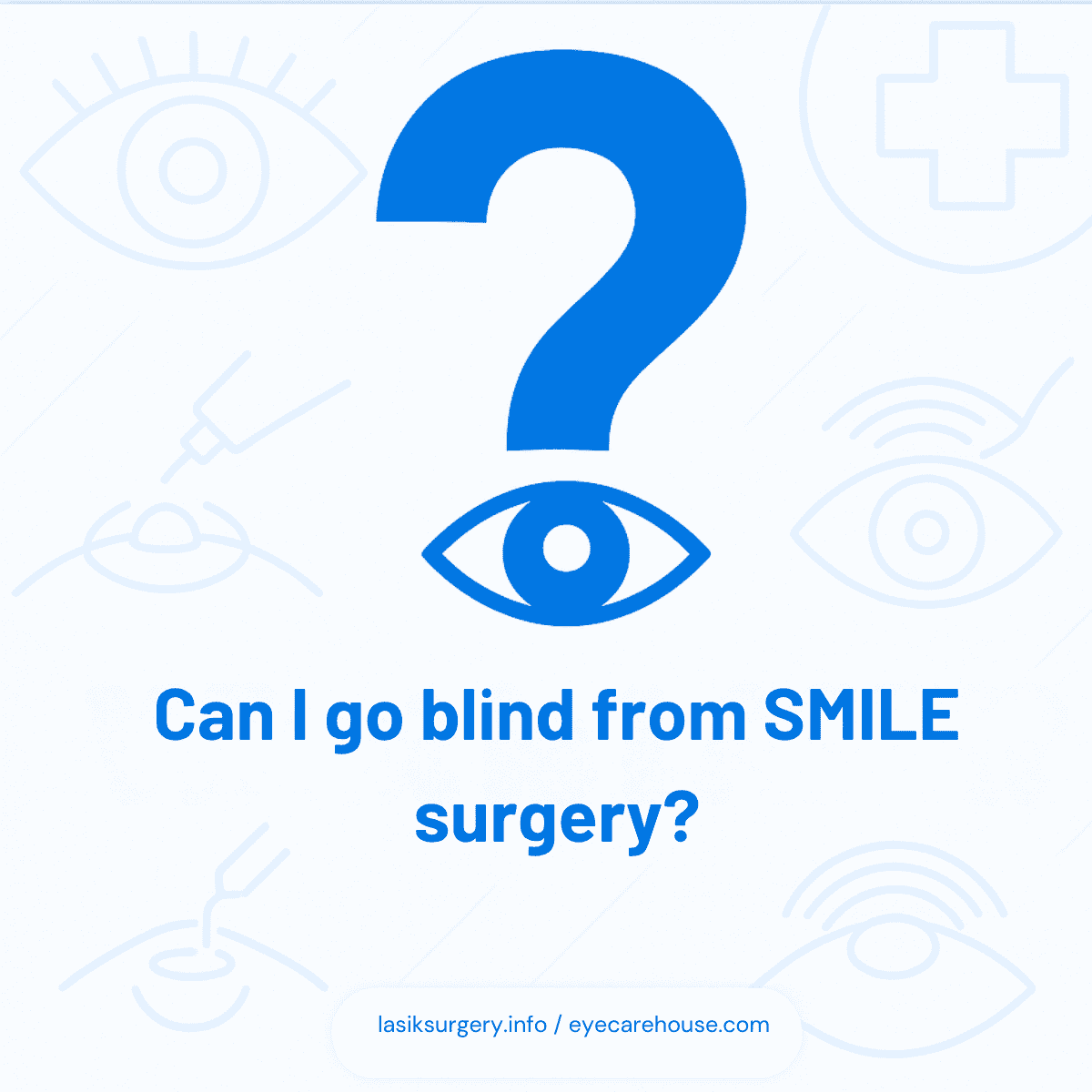
SMILE uses a femtosecond laser to create and remove a corneal lenticule through a small incision, avoiding the need for a flap.
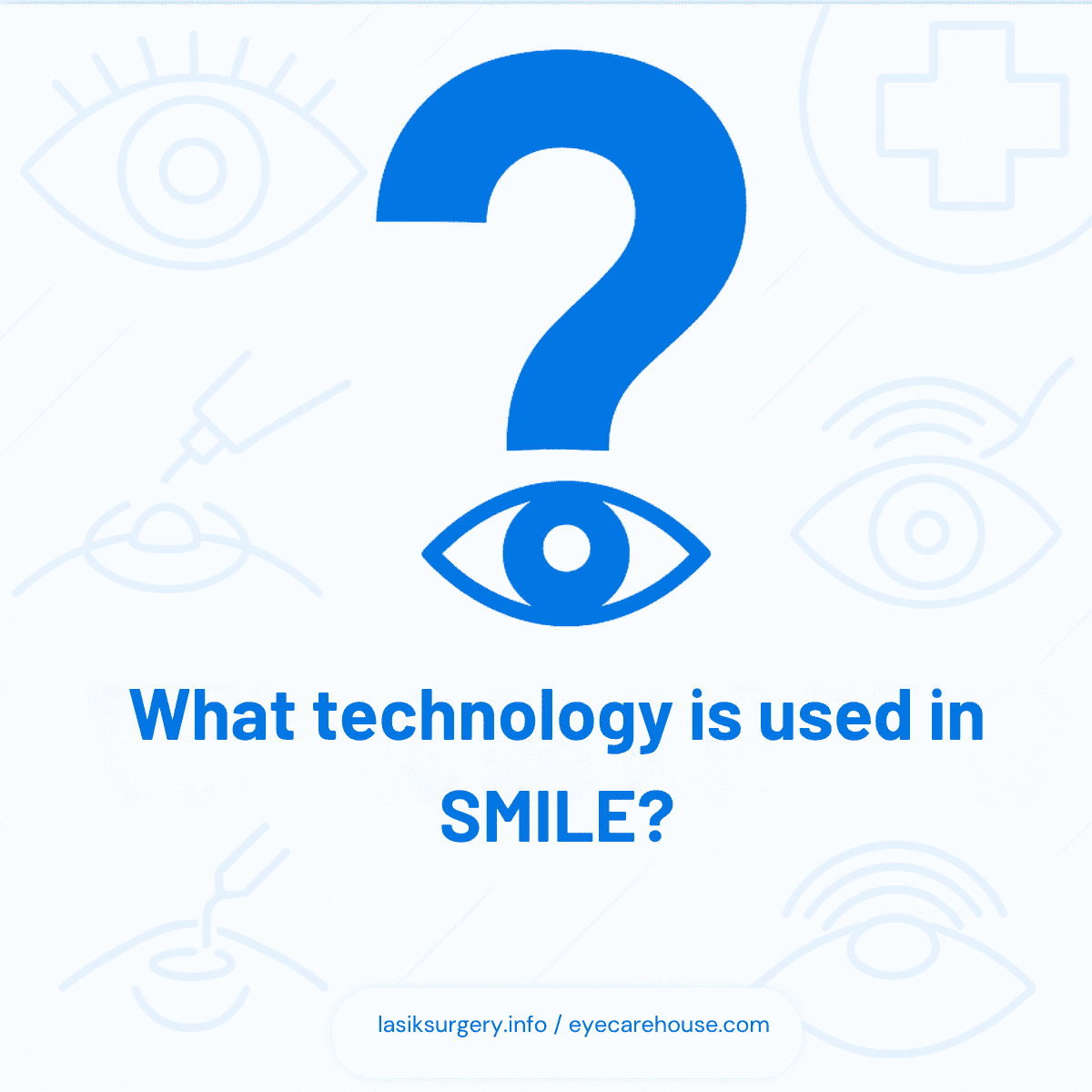
In some cases, an enhancement procedure may be needed years later. SMILE outcomes are generally long-lasting but touch-ups are possible.
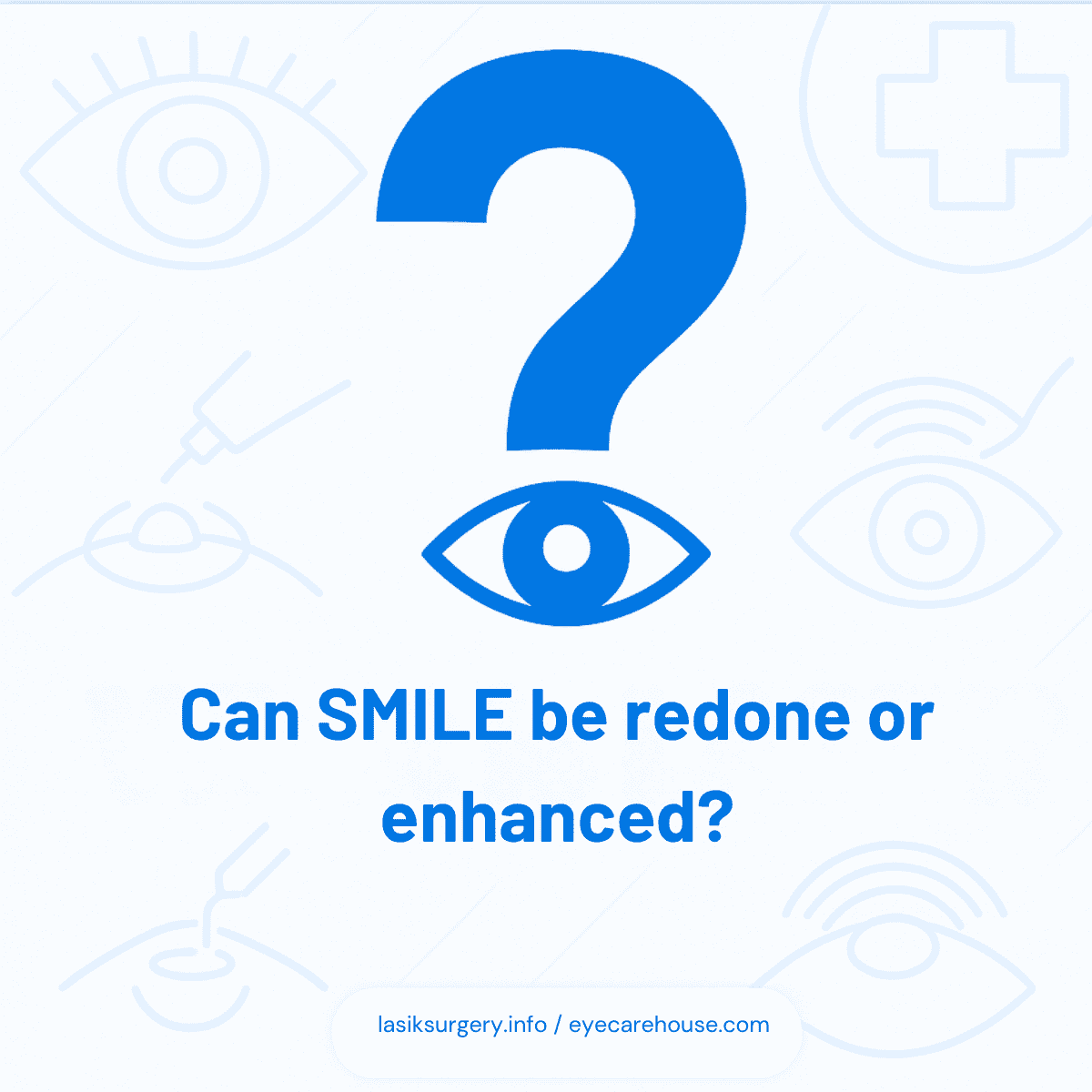
SMILE offers advantages like less dry eye and no flap, while LASIK treats more conditions. The best option depends on your eyes.
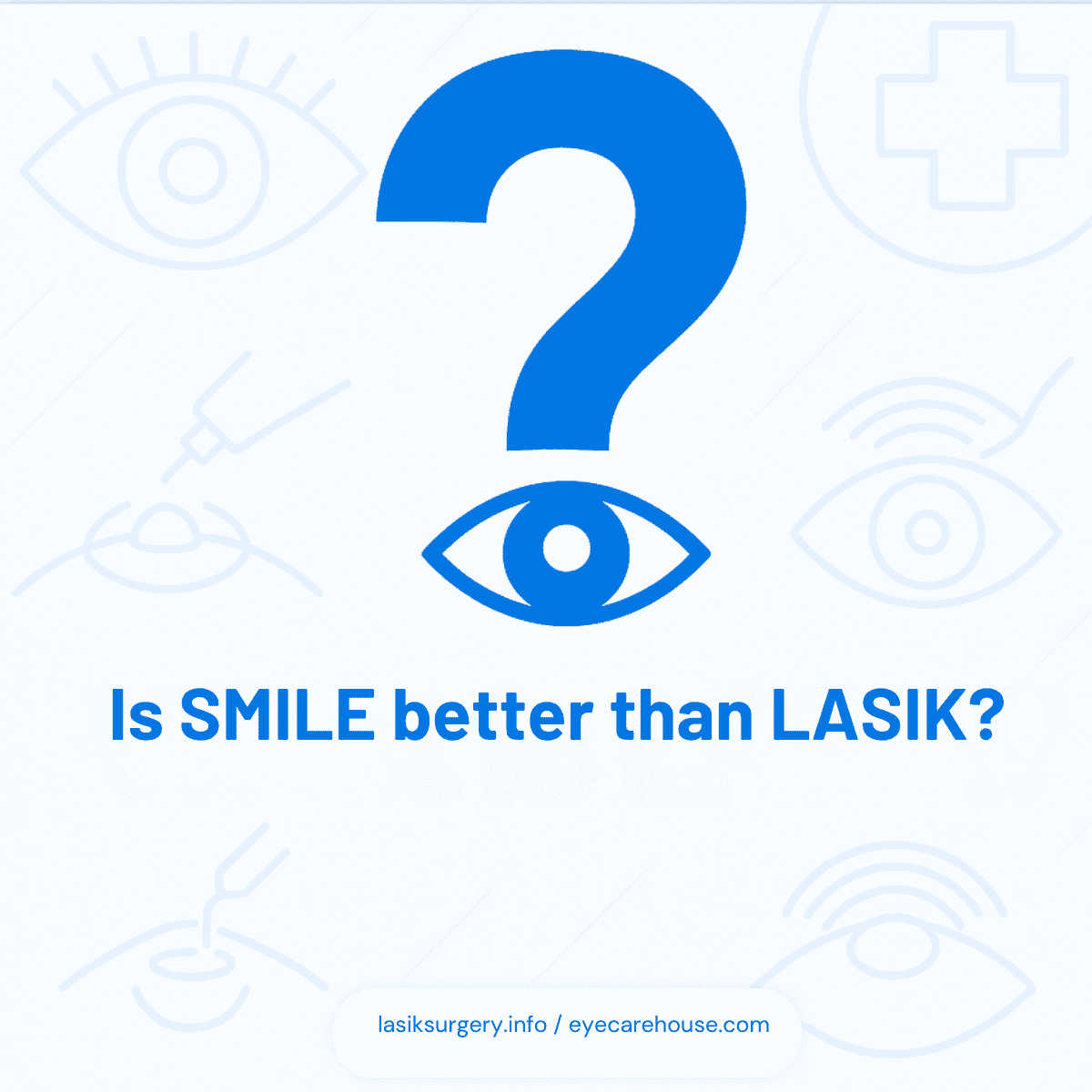
Costs vary but generally range from $2,000 to $3,500 per eye in the U.S. based on location, clinic, and included services.
